mayo 2025 Vol. 24 Edición 4

Cal Poly Humboldt’s Student-Run Bilingual Newspaper

mayo 2025 Vol. 24 Edición 4

Cal Poly Humboldt’s Student-Run Bilingual Newspaper
Cal Poly Humboldt’s special graduations May 15-20 pg. 3
Students get free access to Chat GPT on campus pg. 7
essay: Humboldt Roller Derby pg. 14-15
ofrece recursos bilingües a residentes de Valley West pg. 9
Soy Artista: Cultura chicanx a través de los tatuajes pg. 13
de
con Jessica: Salud intestinal pg. 23


03 Cal Poly Humboldt’s special graduation celebrations May 15-20
04 Traveling: Important information and tips from an attorney
06 New university housing ‘Hinarr Hu Moulik’ set to open this fall
07 Cal Poly Humboldt gives students access to Chat GPT
08 CUNA brings Valley West residents bilingual resources
11 10 local dining spots to celebrate your graduation!
12 Soy Artista: Celebrating Chicanx culture through tattoos
14 Photo essay: Humboldt Roller Derby
17 Opinion: The U.S. crumbles while billionaires rocket to space
18 Opinion: 1 year after the Pro-Palestinian encampments
20 Opinion: At what point is it cyberbullying?
22 Health Talk with Jessica: Tackling nutrition, gut health, and fnals
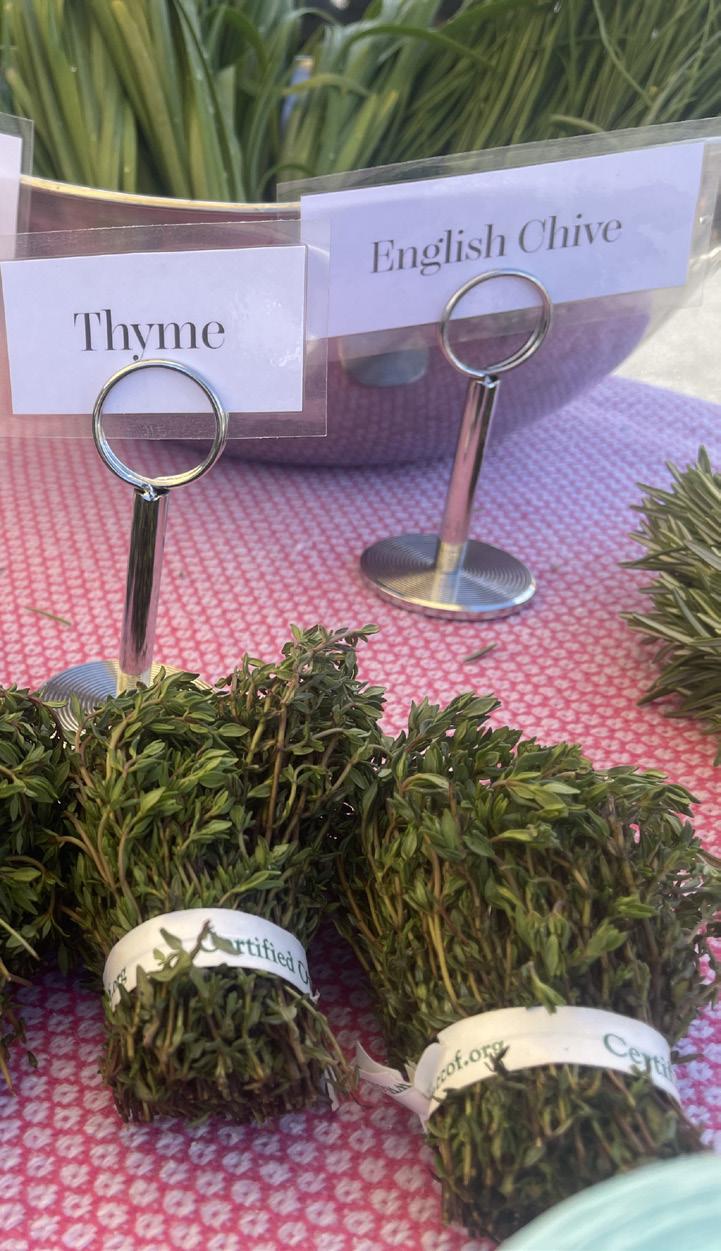
05 Información importante y tips de un abogado cuando viajas
09 CUNA ofrece recursos bilingües a los residentes de Valley West
13 Soy Artista: Celebrando la cultura chicanx a través de los tatuajes
17 Opinión: ¿Por qué enviamos celebridades al espacio?
19 Opinión: 1 año después de los campamentos Pro-Palestinos
20 ¿En qué momento es ciberbullying?
23 Plática de Salud con Jessica: Nutrición, salud intestinal y exámenes fnales
El Leñador is an English and Spanish newspaper produced by Cal Poly Humboldt students. Our staff cover and provide news to Latine and other diverse communities on campus and in Humboldt County. We are committed to providing relevant news and expanding the representations and stories told about people of color and other marginalized groups. Our work helps create more social, political and cultural diversity in local media.
El Leñador es un periódico en español e inglés producido por estudiantes de Cal Poly Humboldt. Nuestro personal cubre y provee noticias a la comunidad Latine y otras comunidades diversas en el campus y en el condado de Humboldt. Estamos comprometidos a brindar noticias actuales y ampliar la representación y las historias que son contadas sobre la gente de color y otros grupos marginados. Nuestros esfuerzos ayudan a crear una diversa presencia social, política y cultural en los medios locales.


Editor in Chief
Maryanne Casas-Perez
Managing Editor
Noelle Doblado
News Editor
Vanessa Saltos
Life & Arts Editor
Ben Hernandez
Layout/Design
Ben Hernandez
Maryanne Casas-Perez
Jordan Pangelinan
Noelle Doblado
Ryndi Greenwell
Writers/Contributors
Jacqueline Zuniga
Ryan Diaz
Ocean Edgar Noelle Doblado
Leslie Castillo
Ryndi Greenwell
Ben Hernandez
Jordan Pangelinan
Guillermo Noe Salazar
Alba Galvan
Jessica De Laguna
Kumiye Nakadate
Joahnna Tool
Translators
Clari Gomez
Joahnna Tool
Maryanne Casas-Perez
Gina Muñoz
Distribution
Guillermo Noe Salazar
Faculty Advisor
Andrea Juarez
Front Cover/Primera Página:
cover by Kumiye Nakadate primera página por Kumiye Nakadate
To advertise with us, email ellenador.ads@gmail.com
El Leñador staf can be reached at el-lenador@humboldt.edu
by Jacqueline Zuniga
Cal Poly Humboldt's 2025 graduation commencement will be held on Saturday, May 17 at the Redwood Bowl. There will also be a commencement ceremony in Southern California located in Beverly Hills on Tuesday, May 20 at the Saban Theater.
Additional ceremonies for students to celebrate their diverse communities will be hosted by El Centro Académico Cultural de Humboldt, Umoja Center for Pan African Student Excellence, Asian, Desi, Pacific Islander, Middle Eastern and North African Center, Indian Tribal and Educational Personnel Program and Queer Student Union.
“It’s to say goodbye to a campus and to a space that's seen them growing, not only as students or scholars or academics but representatives of their community,” said Brenda Perez, coordinator for El Centro.
Schedule for specialty graduations: Thursday, May 15:
Q Graduation Celebration with Queer Student Union
When: Thursday, May 15 at 2:30-4:30 p.m. Where: Blue Lake Sapphire Palace Event Center. Note: Sign-ups are closed on the commencement page. For more information contact qcbc@humboldt. edu. The program will include a performance from the Humboldt Circus, graduation recognition speeches, mingling, food and dancing.
All Native Graduation Celebration with ITEPP
When: Thursday, May 15 at 6-8 p.m. Where: Blue Lake Sapphire Palace Event Center. Note: Sign-ups are closed, but if a student wants to sign up, they should email Sasheen Raymond at ssr19@humboldt.edu. They’ll be honoring Humboldt graduates, then they will honor Huwighurruk Tribal Health Post Baccalaureate Program graduates. Friday, May 16:
Black Grad Ceremony & Celebration with UMOJA
When: Friday, May 16 at 12-2:30 p.m. Where: Blue Lake Sapphire Palace Event Center. Note: To sign-up and for more information: graduating students can still sign up until Friday, May 2, email Alexus-Harrelle Deshazier at hd303@humboldt.edu. Students will have to attend a mandatory pre-grad meeting. The program will include a rose ceremony where students will be sharing a few words about their experience and giving a rose to the person who helped them through their journey. There will also be a performance by local musical artist and poet Ra Mhtp, followed by food and refreshments.
ADPI+MENA Graduation Celebration
When: Friday, May 16 at 4-5:30 p.m.
Where: Blue Lake Sapphire Palace Event Center. Note: Handmade gifts will
be gieven to students. No extension for signups. For more information: contact Frank.Herrera@humboldt.edu.
El Centro Graduation Celebration
When: Friday, May 16 at 5 p.m.
Where: Van Duzer Theater, the program will be in English and Spanish, and will include mariachi and folklorico. Pre-event: 3:30-4 p.m. in the quad for mingling, food, dances, pictures and decompression. Note: No extensions for signups to participate. For more information contact lcae@humboldt.edu.
The information for specialty graduations was provided by Perez from El Centro, Deshazier from Umoja, Alyssa Huynah from ADPI+MENA, Suzette Villarruel from Queer Student Union and Raymond from ITEPP.
More information about commencement ceremonies can be found on the university website: https://commencement.humboldt.edu/celebrations-spring.
by Maryanne Casas-Perez
CPH Palestine will be hosting an art fundraiser at La Ciendita in Arcata to raise money for Palestinian families in Gaza. The event will take place on May 11. Along with the art sale, there will be music from 11 a.m. to 3 p.m.
Ember, one of the CPH Palestine group members who requested not to use his last name for safety reasons, is accepting art donations including jewelry, posters, stickers, canvas art, clothing, patches and preserved food items. North Bound, Los Bagels, Shipwreck, Good Day shop and many other local businesses also donated their art for sale. CPH Palestine will also be giving away original zines with information about Gaza. To donate art for the fundraiser, message the CPH Palestine Instagram account.
“I didn’t have money to donate so that was the way I could do it, it was really cool that everyone else was so willing and happy to contribute and make that possible,” Ember said.
Ember shared that he has had success with these fundraisers back in their hometown, raising over $800 for families in Gaza in the past.
There are multiple families whom CPH Palestine are raising money for. With the help of the money those people in Gaza have been able to meet evacuation funds to travel outside of the country where they will be safe.
“It’s really necessary right now because it’s harder than ever right now for folks to get food and water, a lot of foreign aid on the ground in Gaza has not been able to continue operating, it’s a particularly difficult time,” Ember said.
The items sold will not have a fixed price, allowing people to pay what they can to support the cause and know that their money is going to families who need it.
Octavio Acosta, co-owner of La Ciendita is continuing to provide CPH Palestine the space to host art fundraisers. As a parent, Acosta sees the need to give students the opportunity to help others in any way they can.
“As parents in this season of our life we barely have enough time and resources to get by. We are proud of the younger generations for continuing to question injustices and using their most valuable resources
time and energy to keep this topic on our priority as a community and providing direct aid,” Acosta said.
CPH Palestine will be accepting donations up until the day of the event on May 11. They are mainly accepting crafts and arts, only items they can’t accept is food that isn’t preserved.



by Noelle Doblado
With current changes and enforcement of immigration policies, non-citizen students are experiencing increased anxiety about their safety. Since the start of 2025, 70 Cal State University (CSU) students have been impacted by visa revocations, as of April 15. Cal Poly Humboldt’s Communications Specialist Melissa Hutsell states that CPH currently has 18 international students, and as of April 15, none have been affected by visa revocations.
“University officials are closely monitoring the situation and are in communication with international students and the Chancellor's Office. Due to shifting immigration policies, Cal Poly Humboldt is echoing guidance from the CSU Chancellor’s Office encouraging all students, faculty, and staff to think carefully about any international travel plans, and consider how travel could affect personal safety and the ability to return to the U.S,” Hutsell said.
As of April 30, the Trump administration has restored thousands of student visas. Many of these students had minor legal infractions such as traffic tickets and were not actively in lawsuits about recent mass terminations. The Department of Justice stated that they planned to reactivate the immigration status of students whose status had been recently revoked. Many of those students have already left the country and would need to reapply to study in the U.S.
El Leñador interviewed some CPH students about how they are feeling regarding current immigration policies and how it’s impacting them. Students shared similar sentiments of having a difficult time focusing on school because they are constantly worried about the changing policies and feeling isolated in society by anti-immigrant measures that make it harder to integrate. Some students stated that they feel unsupported by the university, noting that they feel emails from the university about their support haven’t been enough. Additionally, with the semester coming to an end, some feel a heightened anxiety about traveling for summer and returning to school in the fall.
Brenda Perez, the coordinator for El Centro on campus, shares how she is seeing students impacted by the current immigration climate on a daily basis.
“Most of our Latine students are coming from South California and Central Valley and for sure the ICE presence over there is more prominent so they are very concerned
about their relatives,” Perez said. “Some of them unfortunately are taking a break from school to go check on their parents, because for their mental health it's very hard to just be far from family right now.”
Perez is part of a team working to build a Dream Center on campus that will be a resource for undocumented students in the future. As of now, there is no specific launch date.
“The university and the president himself have been publishing communications and public letters to let students know they are in a safe space, not only as a sanctuary county, as a sanctuary city, and now with the Dreamers Center we are reinforcing those protections,” Perez said.
Maricela Amezola, an immigration attorney based in San Diego is the founder of Amezola Legal Group. Amezola shared important legal advice and some tips, non-citizen students to know. Protection in the dorms
The areas on campus that are open to the general public such as the SAC quad and sidewalks, are also open to federal immigration enforcement officers. In dorms, students have a freedom of privacy. If ICE knocks on an individual's dorm room, they cannot enter without a warrant and will need your permission to enter.
“For the most part, immigration officers don't have these warrants, because for that you need probable cause, if that person is first undocumented or has committed an offense against the U.S government,” Amezola said.
If you are living with multiple people, officers only need consent from one person that lives there to enter the room, even if it is not the person the officer is looking for.
Amezola highly suggests if students are living in dorms with roommates, that they have these discussions.
“If they did have an actual warrant to come into the dorm room, they wouldn't ask for permission, they don't need permission because they have an actual warrant signed by a judge, but the majority of them don't, which is why they need your consent,” Amezola said.
Interacting with ICE
Amezola states that every case is different and it is important that if you are concerned about your status that you find an immigration attorney to consult with. In the case that you do come into contact with ICE, Amezola notes the following:
If approached by ICE, ask “Why are you

stopping me?” and “Who are you looking for?”
If the person they are looking for is NOT you, state that it is not you and ask “Am I free to go?” and the officer must respond with yes or no. If the individual is the person the officer is looking for, then they must comply and they have the constitutional right to remain silent and to speak to an attorney.
Unless the officer has a warrant signed by a judge, the individual can withhold consent for searches and seizures.
In the case that ICE violates these rights, Amezola emphasizes the importance of paying attention to the details of the interaction, such as the officer’s name and how you were stopped, as they will be valuable in court.
“All these details matter for when you're fighting a motion to suppress in immigration court, which is to suppress the evidence that led to them finding out it was you unlawfully and now you're being deported or trying to be deported,” said Amezola. Identification at protests
Amezola emphasizes that under the current presidential administration, non-citizen students involved in protests for the Israel and Palestine war are being brought into detention and questioning. She calls attention to the recent cases of students being identified through cameras or facial recognition, and that agents have then determined an individual's status, thus bringing them into questioning.
On April 9, the U.S. Citizenship and Immigration Services stated that the Department of Homeland Security will “begin considering aliens’ antisemitic activity on social media and the physical harassment
of Jewish individuals as grounds for denying immigration benefit requests. This will immediately affect aliens applying for lawful permanent resident status, foreign students and aliens affiliated with educational institutions linked to antisemitic activity”. Travel and social media
Circumstances for travel vary with different statuses for non-citizens.
“Green card holders should have no issue. They are protected unless the green card holder has some type of protest or situation happening in their phones or in their social media, because the government did issue an executive order indicating that social media will be scanned [for] every non-citizen,” Amezola said. “Regarding the dreamers, they are not allowed to travel outside of the United States, so travel inside of the US is fine.”
For any non-citizen, especially students on student visas, Amezola advises that if they have any unpaid tickets such as driving, parking, or DUI, that they take care of it immediately before travel.
“They need to go speak to an attorney before they fly out. Those are the students that are now being flagged,” Amezola said. For more information about immigration rights and resources, financial aid, career development, cultural centers and campus liaisons for undocumented students visit the following:
https://www.humboldt.edu/immigration/ dreamer-student-resources
https://www.humboldt.edu/immigration For free immigration legal services visit: https://www.humboldt.edu/immigration/ free-immigration-legal-services
Escrito por Noelle Doblado y traducido por Gina Muñoz
Con los cambios actuales y la aplicación de las políticas migratorias, los estudiantes extranjeros experimentan una mayor ansiedad por su seguridad. Desde principios de 2025, 70 estudiantes de la Universidad Estatal de California (CSU) se han visto afectados por la revocación de visas, hasta el 15 de abril. Melissa Hutsell, especialista en comunicaciones de Cal Poly Humboldt, afirma que CPH cuenta actualmente con 18 estudiantes internacionales y, hasta el 15 de abril, ninguno se ha visto afectado por la revocación de visas.
“Las autoridades universitarias están monitoreando de cerca la situación y se mantienen en comunicación con los estudiantes internacionales y la oficina del rector del sistema CSU. Debido a los cambios en las políticas migratorias, Cal Poly Humboldt hace eco de las acciones de la oficina del rector de CSU, animando a todos los estudiantes, profesores y personal a considerar cuidadosamente cualquier plan de viaje internacional y cómo este podría afectar su seguridad personal y su posibilidad de regresar a EE. UU.”, dijo Hutsell.
Desde el 30 de abril, la administración Trump había restaurado miles de visas de estudiantes. Muchos de estos estudiantes tenían infracciones legales menores, como multas de tráfico, y no participaban activamente en demandas relacionadas con las recientes cancelaciones masivas de visas. El Departamento de Justicia declaró que planeaba reactivar el estatus migratorio de los estudiantes cuyo estatus había sido revocado recientemente, y muchos de ellos ya habían salido del país y tendrían que volver a solicitar estudiar en EE. UU.
Cómo se ven afectados los estudiantes
El Leñador entrevistó a algunos estudiantes de CPH sobre cómo se sienten con respecto a las políticas migratorias actuales y cómo les están afectando. Los estudiantes compartieron sentimientos similares: les cuesta concentrarse en la escuela debido a la constante preocupación por los cambios en las políticas y al aislamiento social causado por las medidas anti-inmigratorias que dificultan su integración. Algunos estudiantes afirmaron no sentirse apoyados por la universidad, y señalaron que los correos
electrónicos de apoyo recibidos no les han sido suficientes. Además, con el fin del semestre, algunos sienten una mayor ansiedad por viajar durante el verano y regresar a la escuela en otoño.
Brenda Pérez, coordinadora de El Centro en el campus, compartió cómo ve a diario el impacto del clima migratorio actual en los estudiantes.
“La mayoría de nuestros estudiantes latinos provienen del sur de California y del Central Valley, y sin duda la presencia de ICE allí es mayor, así que están preocupados por sus familiares,” dijo Pérez. “Algunos, lamentablemente, se están tomando un descanso de la escuela para ir a ver a sus padres, porque es muy difícil para su salud mental estar lejos de su familia en este momento.”
Pérez forma parte de un equipo que trabaja para construir un Dream Center en el campus que será un recurso para estudiantes indocumentados en el futuro. Hasta el momento no hay una fecha de lanzamiento específica.
“La universidad y el propio presidente han estado publicando comunicados y cartas públicas para informarle a los estudiantes que se encuentran en un espacio seguro, no solo en un condado santuario, sino también como una ciudad santuario, y ahora, con el Dreamers Center, estamos reforzando esas protecciones”, dijo Pérez.
Asesoramiento legal y consejos de una abogada de inmigración
Maricela Amezola, abogada de inmigración con sede en San Diego, es la fundadora de Amezola Legal Group. Amezola compartió importantes consejos legales y algunos consejos que los estudiantes sin ciudadanía deben saber. Protección en los dormitorios
Las áreas del campus abiertas al público en general, como el patio del SAC y las aceras, también están abiertas a los agentes federales de inmigración. En los dormitorios, los estudiantes tienen libertad de privacidad. Si ICE toca la puerta de la habitación de una persona, no podrán entrar sin una orden judicial y necesitarán su permiso.
“En la mayoría de los casos, los oficiales de inmigración no cuentan con estas órdenes judiciales, ya que para ello se
necesita causa probable, si la persona es indocumentada o ha cometido un delito contra el gobierno de Estados Unidos,” dijo Amezola.
Si vive con varias personas, los oficiales solo necesitan el consentimiento de una de ellas para entrar en la habitación, incluso si no es la persona que buscan. Amezola recomienda fuertemente que, si los estudiantes comparten espacio con otros, tengan estas conversaciones.
“Si tuvieran una orden judicial para entrar en la residencia, no pedirían permiso; no lo necesitan porque tienen una orden judicial firmada por un juez, pero la mayoría no la tienen, por eso necesitan su consentimiento,” dijo Amezola. Interacción con ICE Amezola afirma que cada caso es diferente y que es importante que, si le preocupa su estatus migratorio, consulte con un abogado de inmigración. En caso de que entre en contacto con ICE, Amezola señala lo siguiente:
Si ICE se acerca a usted, pregunté "¿Por qué me detiene?" y "¿A quién busca?"
Si la persona que buscan NO es usted, dígalo y pregunte "¿Puedo irme?". El oficial debe responder sí o no. Si la persona es la que busca el oficial, debe cumplir y tiene el derecho constitucional a guardar silencio y hablar con un abogado.
A menos que el oficial tenga una orden judicial firmada por un juez, usted puede negar su consentimiento para inspecciones y confiscaciones.
En caso de que ICE viole estos derechos, Amezola enfatiza la importancia de prestar atención a los detalles de la interacción, como el nombre del oficial y cómo lo detuvieron, ya que serán valiosos en el tribunal.
“Todos estos detalles son importantes cuando se está impugnando una moción de supresión en inmigración. Esto significa suprimir la evidencia que les permitió descubrir que eras ilegal y que ahora estás siendo deportado o a punto de serlo”, dijo Amezola.
Identificación en protestas Amezola enfatiza que, bajo la actual administración presidencial, los estudiantes sin ciudadanía que participan en protestas por la guerra entre Israel y Palestina están siendo detenidos e interrogados. Llama la atención a casos recientes de estudiantes identificados mediante
cámaras o reconocimiento facial, y que los agentes han determinado el estatus migratorio de una persona, lo que la ha llevado a ser interrogada.
El 9 de abril, el U.S. Citizenship and Immigration Services declaro que el Department of Homeland Security “comenzará a considerar la actividad antisemita de extranjeros en redes sociales y el acoso físico a personas judías como motivos para denegar solicitudes de beneficios migratorios.” Esto afectará inmediatamente a los extranjeros que solicitan la residencia permanente legal, a los estudiantes extranjeros y a los extranjeros afiliados a instituciones educativas vinculadas con actividades antisemitas. Viajes y redes sociales
Las circunstancias para viajar varían según el estatus de los estudiantes sin ciudadanía.
“Los titulares de tarjetas de residencia permanente no deberían tener problemas. Están protegidos a menos que tengan algún tipo de protesta o situación en sus teléfonos o redes sociales, ya que el gobierno emitió una orden ejecutiva que indica que se escanearán las redes sociales de todos los no ciudadanos”, dijo Amezola. “En cuanto a los dreamers, no se les permite viajar fuera de Estados Unidos, por lo que viajar dentro del país está bien”.
Para cualquier estudiante sin ciudadanía, especialmente para estudiantes con visas de estudiante, Amezola aconseja que, si tienen alguna multa pendiente, como por conducir, estacionar o conducir bajo los efectos del alcohol, la solucionen inmediatamente antes de viajar.
“Deben hablar con un abogado antes de volar. Esos son los estudiantes que ahora están siendo detenidos”, dijo Amezola.
Para más información sobre derechos y recursos migratorios, ayuda financiera, desarrollo profesional, centros culturales y enlaces en el campus para estudiantes indocumentados, visite: https://www.humboldt.edu/immigration/dreamer-student-resources https://www.humboldt.edu/immigration Para servicios legales gratuitos de inmigración, visite: https://www.humboldt. edu/immigration/free-immigration-legal-services
by Vanessa Saltos
This August transfer and continuing Cal Poly Humboldt students have the option to move into the new campus housing, located off the intersection of St. Louis Road and Hwy 101.
The new housing complex, which is set to have a total of 964 beds, has been officially named “Hinarr Hu Moulik” (pronounced hee-NOD huh MOO-leek) meaning “Our Home” in Yurok. The east building will be completed in June and will be able to house about 550 residents. The west building will be open by spring 2026.
Inside each apartment, students will have a living room space, a sink/vanity outside and inside the bathroom, a toilet and a bathtub/shower combo. The kitchen includes a refrigerator, stovetop, microwave, sink, oven and dishwasher.
Students have three room styles to choose from, said Project Manager Fred Saldana in an email:
• Two bedroom doubles (four-person), with two vanities/sinks and one bath.
• Three bedroom doubles (six-person), with three vanities/sinks and two baths.
• Four bedroom singles (four-person), with two vanities/sinks and two baths.
Square footage for each apartment are as follows:
• Two bedroom doubles are 734 square feet.
• Three bedroom doubles are 1077 square feet.
• Four bedroom singles are 914 square feet.
Bedrooms themselves will range from 83 to 114 square feet for singles, and 153 to 166 square feet for doubles, said Saldana.
This differs slightly from the College Creek Apartments, which were built in 2008. In College Creek, a single bedroom is 110 square feet and a double bedroom is 165 square feet.
A recreational area will be available for students that will include two pickleball
courts, two ping pong tables, a volleyball court and a half court for basketball. An exercise room will also be available on the first floor of the east building.
As for parking, 283 spots will be available for students this fall. However, once the complex is completed, there will be a total of 328 spots.
Students should also note that they will not have access to the laundry room until the whole complex is completed. Students can go to the East Side Laundromat on LK Wood which is located about 0.5 miles away.
For the 2025-2026 academic year, rent for all university housing is increasing about 5% to reflect the rising operational and maintenance costs, including utilities and mandated staff salary increases, said Senior Director for Housing & Residence Life Donyet King in an email.
“Without these adjustments, essential services like equipment maintenance, safety systems, and other services could be negatively impacted,” King said. “Additionally, the university is still recovering financially from the aftermath of the COVID-19 pandemic, which significantly impacted housing revenues. As part of the university’s long-term planning, Cal Poly Humboldt has been investing in expanded housing options, like the new Hinarr Hu Moulik community, to support increased student enrollment. These efforts are partly funded through housing fees.”
Out of the 23 CSU’s, Cal Poly Humboldt still remains one of the more affordable campuses, said King, ranking fifth lowest in room rates and eighth lowest in combined room and meal plan costs.
That said, the university regularly reviews housing rates to ensure they stay competitive with the local housing market, while continuing to prioritize a quality, supportive living experience for students, said King.
“It’s also important to note that the Student Fee Advisory Committee receives information about proposed housing and dining fee increases annually, allowing them to provide feedback before
any fees are approved,” King said.
The academic year rent is increasing on average about $400. Starting this fall, students living in university housing are also required to pay for a meal plan.
At Hinarr Hu Moulik there will be a cafe/market where students can use meal exchanges and flex dollars to buy food and other items. The only location that currently allows students to use meal swipes is the J Dining Hall on the main campus.
“Meal plans are now required in all areas of housing, as this plays a key role in recruitment and retention,” King said. “In addition to ensuring equitable, convenient, and consistent access to dining across campus, this also fosters a sense of community, supports student well-being, and contributes to overall student success.”


by Ryan Diaz
As artificial intelligence is on the rise, various institutions are beginning to integrate AI into their operations and education. The California State University Chancellor’s Office announced last February its plan to enhance student education using AI across all campuses.
AI in education has sparked discussion for credibility, academic dishonesty and bias among other things. Until recently, AI was subject to debate in the academic space, but as of early this year, it was announced that CSUs would adopt AI as a tool.
Cade Webb, acting chief information officer of Information Technology Services (ITS) at Cal Poly Humboldt, has insight into the purpose and integration of AI into CSUs.
“The purpose of integration, from a quote from the chancellor, ‘this initiative will elevate the CSU student experience, enhancing student success and personalized and teacher-focused learning tools across all fields of study, preparing our increasingly AI-driven workforce,’” Webb said. “We are thinking about preparing students for the workforce, having AI skills. There are a couple of components to that one is the workforce readiness, the second one is called the digital divide.”
The idea is that with this integration of AI, students will be more prepared for the workforce. While the purpose is made clear, there are privacy concerns about data and how it is used with AI.
“ChatGPT is offered in a secure manner, you have to use your Humboldt account to log into it. It doesn’t use student data to train other models,” Webb said.
Two students share their concerns about AI being used on campus. Axel Tristan, a junior at Cal Poly Humboldt studying wildlife, has concerns about the implementation of AI.
“I don’t understand what [Cal Poly Humboldt] will be using the integration [of AI] for. I am not a huge fan of AI, I think it's stealing a lot of important jobs and duties from people who could do the jobs the same,” Tristan said.
Jazmine A. is a third-year student at Cal Poly Humboldt who shares the same sentiment.
“I personally don't agree with using AI in anything other than accessibility reasons, since I don’t know what the CSU wants to use it for,” Jazmine said.
Dr. Enoch Hale, director of the Center

for Teaching and Learning and Academic Technology at Cal Poly Humboldt, also has an understanding of local AI integration.
“The chancellor's office had the goal of providing a more secure environment for ChatGPT. We saw that 3,000 people were using free accounts already with ChatGPT, with the paid license providing everyone with a more secure environment,” Hale said.
Other factors in the AI integration that surface are its accessibility to students, staff and faculty.
Breck Robinson, director of Customer Care with ITS at Cal Poly Humboldt, answers questions regarding the accessibility and digital divide within the implementation and integration of AI on campus.
“ChatGPT is available to all students, faculty and staff on campus,” Robinson said. “The digital divide is certainly a huge issue across the country. This does provide the edu higher-level version for all students and all campuses. Students who could not afford to pay for the higher-level
licences now have access to it.”
“We at ITS and across campus are very concerned with accessibility, people who have any sort of disability being able to use these tools. Our accessibility team has been working with OpenAI to ensure that these tools are possible. There are some things OpenAI needs to work on, and it's a part of the CSU’s agreement with them that they are going to get these accessibility issues resolved,” Robinson said.
The digital divide is the line between those with access to modern technology, like computers, and those who do not. This line creates an education gap, and addressing that disparity is a goal in this rollout of AI in education.
“We do have a contract with Chat [GPT] to make sure that these accessibility issues are fixed by the end of the calendar year,” Hale said.
Resources with a landmark launch have been implemented to cater to the new AI era of education.
“The AI commons is a resource available to students, faculty and staff that
utilizes resources from other campuses,” Webb said.
“We have courses with AI embedded in them, where faculty, when designing their own academic courses this is different ways we can use AI. We have grants that we work with, we have research projects that we work with that highlight different ways and problems and challenges with using AI,” Hale said.
There is an event called "Slice of AI and Pie” where different people come in and talk about different aspects of AI tools and how to use it. ITS hopes to have some of the major AI companies come out and talk about it, and other professionals in the field, Webb said.
While the utilization is effective, it is not permanent in an ever-changing society.
“From a financial lens, we have access until July of 2026, at that time, we can evaluate the market because things are changing so fast,” Webb said.
by Ocean Edgar
Community United of North Arcata (CUNA) is a bilingual community-led organization in North Arcata/Valley West founded by volunteers. CUNA aims to create opportunities for the community of North Arcata and give them a platform to voice issues that are specific to their needs. CUNA’s “boots on the ground” approach has led to collaboration between residents, local businesses and city government, with the focus of enhancing the quality of life for the Valley West community.
“We were born during the pandemic in response to COVID, and what we saw was that the Spanish speaking community had fallen between the cracks because of the language barrier,” said Vice-Mayor and Arcata City Councilmember Kimberly White.
White is one of the founders and co-coordinator of CUNA, she has lived in Valley West for 20 years. CUNA’s policy
is to make everything they do bilingual and safe for all members of the community.
“I really feel like we are building a bridge to the city,” White said. “[CUNA] just sort of filled the gap, not just for the Spanish speaking community but we have the students who can’t afford to live high on the hill or in the dorm or downtown Arcata. We have most of the affordable housing, almost all of the mobile home parks, and most of the unhoused live out here.”
According to White the residents of North Arcata represent some of the city’s most vulnerable populations who often feel neglected by the City of Arcata’s plans and infrastructure. CUNA has hosted community trash cleanups of parks and sidewalks, vaccination clinics, artisan markets, family friendly events and mural painting. In 2022 they adopted Carlson Park, which has the only Mad River
access point in the City.
Jazmin Ortiz Uribe, a Social Work major at Cal Poly Humboldt, found CUNA while looking for an organization to volunteer for in fall of 2024, and has continued to be involved ever since.
“I really hope to continue to see more of our Latinx community come to our events and hopefully feel super safe with us and like this is for them as well… I want to let them know that we’re here for you guys and we want to make sure that you guys are feeling welcome in this space,” Ortiz Uribe said.
Hub
Last November CUNA acquired a home at 4700 East Valley West, and used funds from a PG&E $100,000 grant awarded to its physical sponsor Playhouse Arts to establish a “Resilience HUB", which during emergencies will serve as a center where residents can access emergency supplies, charge devices, let family and friends

know they are safe and to keep each other updated on next steps. Throughout the year the Resilience HUB is hosting other programs and disaster preparedness events, all of them will be bilingual.
CUNA also provides resources which address food scarcity, including a future Food Pantry and a monthly Farmer’s Market/Food Stand with affordable produce from local farms. They recently hosted an eight week Nutrition Food Demo, which included free ingredients and instructions on how to prepare healthy and affordable meals at home.
The organization also received a $25,000 ARPA grant and held a participatory budget for Valley West residents. The participatory budget is the first of its kind in Humboldt County; all of the funds will be spent on events and programs the Valley West community voted for.
Some of these are already established and held weekly, such as Xtreme Baile Terapis, a dance/yoga class taught by Dr. Jorge Matías every Tuesday at 6:30 p.m., while other events are held monthly, including Teen Meetups and free cooking classes taught by local chefs. All of these events are free or donation based.
“So many people don’t know about it, but [CUNA] is such a great melting pot,” said Daniel Malloy, an Arcata resident who lived in Valley West for 12 years. Malloy regularly volunteers with CUNA and attends various programs and events.
“It brings us all together and helps us despite differences… It's been really good for trying to get people together and step across cultural and social boundaries,” Malloy said.
Other upcoming events will take place in May and June, with dates still to be decided. These will include a Tianguis (Latinx-style flea market), a Food Truck Festival featuring a variety of international foods, Movies at the Park and Music in the Park. A full breakdown of the participatory budget and planned events and services is available on CUNA’s website.
More information about upcoming events and volunteer opportunities contact CUNA.
CUNA’s website: https://www.cunacomestogether.com/ Instagram: @cunacomestogether
Escrito por Ocean Edgar y traducido por Maryanne Casas-Perez
Comunidad Unida del Norte de Arcata (CUNA) es una organización bilingüe dirigida por la comunidad en el Norte de Arcata/Valley West, fundada por voluntarios. CUNA tiene como objetivo crear oportunidades para la comunidad del Norte de Arcata y brindarles una plataforma para expresar los temas que son específicos a sus necesidades. El enfoque de CUNA ha fomentado la colaboración entre residentes, negocios locales y el gobierno de la ciudad, con el propósito de mejorar la calidad de vida de la comunidad de Valley West.
“Nacimos durante la pandemia como respuesta al COVID, y lo que vimos fue que la comunidad hispanohablante había quedado rezagada debido a la barrera del idioma”, dijo Kimberly White, vicealcaldesa y miembro del Concejo Municipal de Arcata.
White es una de las fundadoras y co-coordinadoras de CUNA, y ha vivido en Valley West durante 20 años. La política de CUNA es hacer todo de manera bilingüe y segura para todos los miembros de la comunidad.
“Siento que realmente estamos construyendo un puente hacia la ciudad”, dijo White. “[CUNA] simplemente vino a llenar ese vacío, no solo para la comunidad hispanohablante, sino también para los estudiantes que no pueden darse el lujo de vivir en lo alto de la colina, en los dormitorios o en el centro de Arcata. Tenemos la mayoría de la vivienda asequible, casi todos los parques de casas móviles, y la mayoría de las personas sin hogar viven aquí.”
Según White, los residentes del Norte de Arcata representan algunas de las poblaciones más vulnerables de la ciudad, quienes a menudo sienten que los planes e infraestructura de Arcata los han dejado de lado. CUNA ha organizado limpiezas comunitarias de basura en parques y aceras, clínicas de vacunación, mercados artesanales, eventos familiares y la pintura de murales. En 2022, adoptaron Carlson Park, que cuenta con el único acceso al Mad River en la ciudad.
Jazmin Ortiz Uribe, estudiante de Trabajo Social en CPH, encontró a CUNA mientras buscaba una organización para hacer voluntaria en el otoño de 2024, y desde entonces ha seguido participando. “Realmente espero ver a más miem-
bros de nuestra comunidad latina asistir a nuestros eventos y que se sientan súper seguros con nosotros, que sepan que esto también es para ellos... Quiero que sepan que estamos aquí para ustedes y que queremos asegurarnos de que se sientan bienvenidos en este espacio”, dijo Ortiz Uribe.
Centro de Resiliencia (Resilience Hub)
El pasado noviembre, CUNA adquirió una casa en el 4700 East Valley West, y utilizó fondos de una subvención de $1 millón otorgada por PG&E a su patrocinador físico Playhouse Arts para establecer un Centro de Resiliencia ("Resilience HUB"), que durante emergencias servirá como un centro donde los residentes podrán acceder a suministros de emergencia, cargar dispositivos, informar a familiares y amigos que están a salvo y mantenerse actualizados sobre los próximos pasos. Durante el resto del año, el Centro de Resiliencia organiza otros programas y eventos de preparación para desastres, todos bilingües.
CUNA también ofrece recursos para abordar la escasez de alimentos, incluyendo una futura Despensa de Alimentos y un Mercado de Agricultores/Puesto de Alimentos mensual con productos asequibles de granjas locales. Recientemente organizaron una demostración de cocina de nutrición de ocho semanas, que incluyó ingredientes gratuitos e instrucciones sobre cómo preparar comidas saludables y accesibles en casa.
La organización también recibió una subvención ARPA de $25,000 y llevó a cabo un presupuesto participativo para los residentes de Valley West. Este presupuesto participativo es el primero de su tipo en el condado de Humboldt; todos los fondos se utilizarán en eventos y programas que la comunidad de Valley West votó.
Algunos de estos programas ya están establecidos y se llevan a cabo semanalmente, como Xtreme Baile Terapis, una clase de baile/yoga impartida por el Dr. Jorge Matías todos los martes a las 6:30 p.m., mientras que otros eventos son mensuales, incluyendo encuentros para adolescentes y clases de cocina gratuitas impartidas por chefs locales. Todos estos eventos son gratuitos o basados en donaciones.
“Mucha gente no lo sabe, pero [CUNA] es un gran crisol cultural”, dijo Daniel Malloy, residente de Arcata que vivió en Valley West durante 12 años. Malloy es voluntario
regular en CUNA y asiste a diversos programas y eventos.
“Nos une a todos y nos ayuda a pesar de nuestras diferencias... Ha sido muy positivo para reunir a las personas y cruzar las barreras culturales y sociales”, dijo Mallory.
Otros eventos programados se llevarán a cabo en mayo y junio, con fechas aún por definir. Estos incluirán un Tianguis, el Festival de Food Trucks con una variedad de comidas internacionales, Cine en el
Parque y Música en el Parque. Un desglose completo del presupuesto participativo y los eventos y servicios planeados está disponible en el sitio web de CUNA. Para más información sobre próximos eventos y oportunidades de voluntariado, contacte a CUNA. Sitio web de CUNA: https://www. cunacomestogether.com/ Instagram: @cunacomestogether
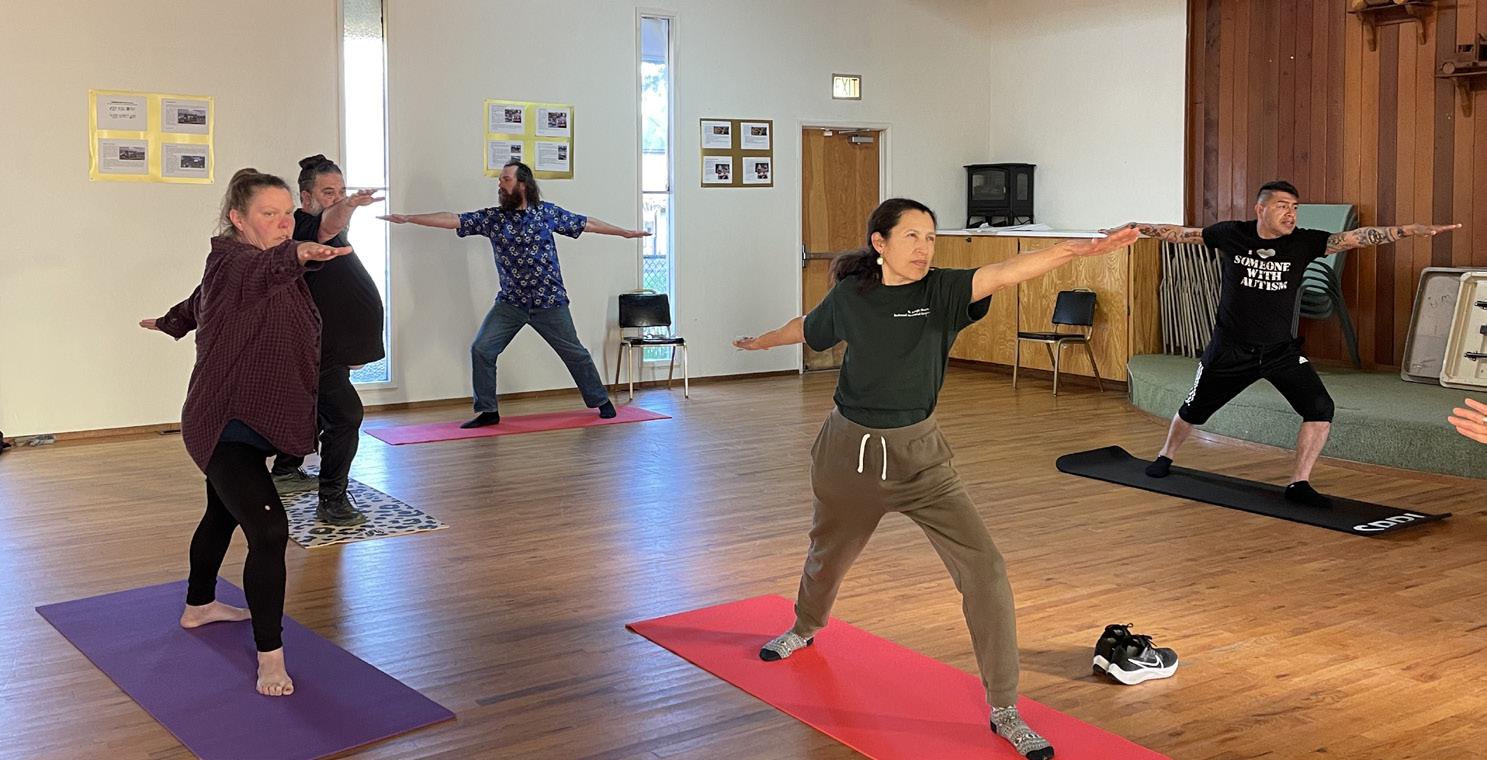
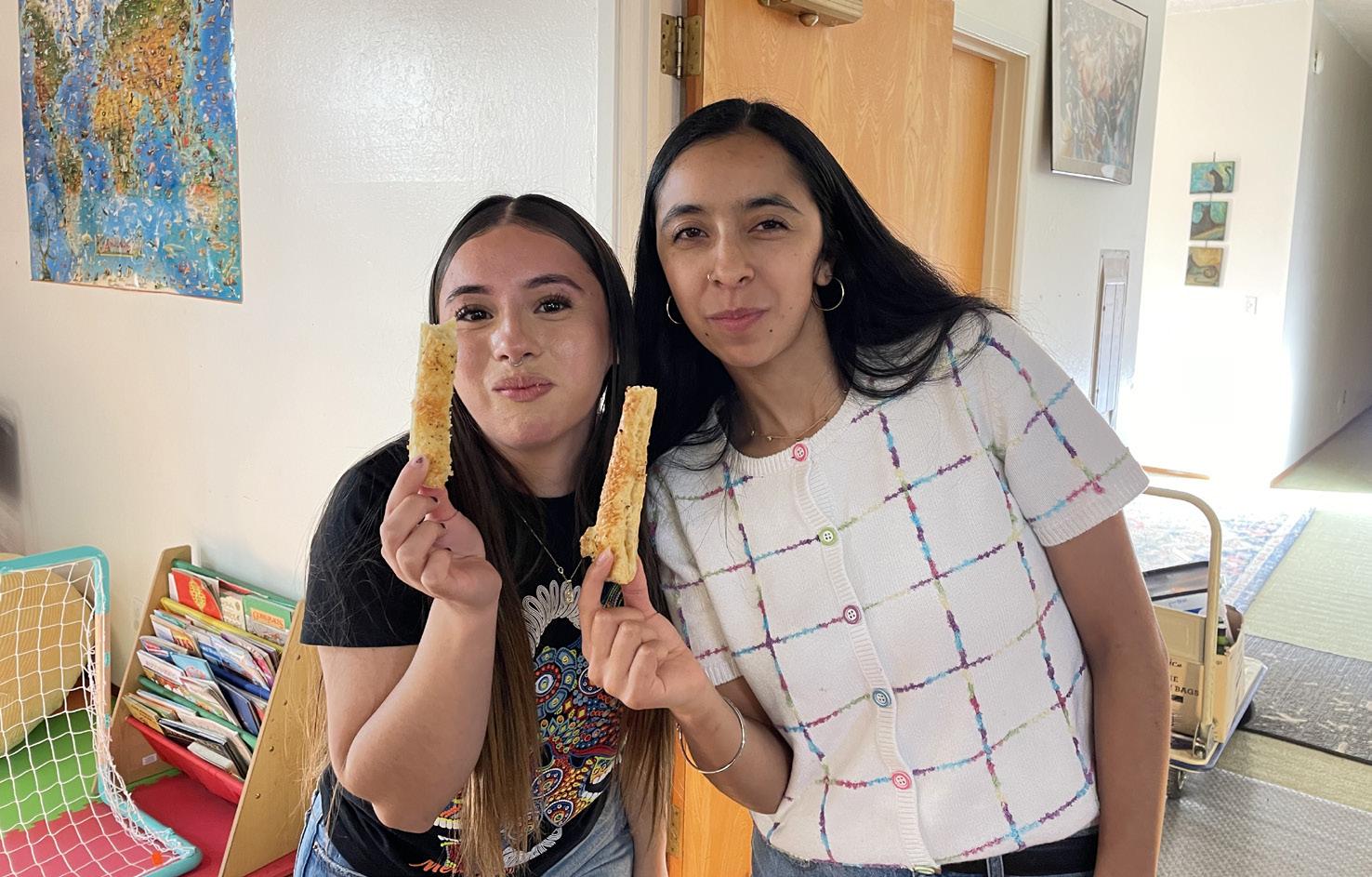

Tómate el tiempo para hablar con ella sobre los peligros del alcohol. Comenzar conversaciones cortas y frecuentes sobre el consumo de alcohol a una edad temprana es el primer paso para mantener a su hijo/a seguro/a e informado/a.

Para obtener consejos sobre cómo y cuándo comenzar la conversación, visita underagedrinking.samhsa.gov.






Don’t wait! These fall classes apply toward the Sustainable Food Systems Minor
CORE CLASSES IN FALL
RRS 306 Rangeland Management Principles HED 231 Basic Human Nutrition NAS 309 TEK and Indigenous NR Management
ELECTIVES (6 units needed): ANTH 329 Critical Archival Studies • BA 106 Advocating for Sustainability • COMM 300 Contemporary Public Discourse • ECON 306W Econ of the Developing World • ESM 355 Principles of Ecological Restoration • FISH 370 Aquaculture • GEOG 300 Global Awareness • HED 231 Basic Human Nutrition • INTL 410W Global Issues Analysis • JMC 160 El Leñador News • NRSG 470 Community/Public Health Nursing • PHIL 302 Environmental Ethics • WDLF 309 Case Studies in Environmental Ethics • WSHD 458 Climate Change and Land Use • BA 432 Leading Sustainable Businesses • COMM 309B Gender and Communication • ECON 309 Economics of a Sustainable Society • ECON 423 Environmental and Natural Resources Economics
MORE INFO: Email Advisor Marissa Ramsier at anth@humboldt.edu

by Guillermo Noe Salazar and Ben Hernandez
Since she was five years old, Alexa Moreno knew she wanted to become a tattoo artist.
“I used to do this thing where I would buy temporary tattoos at the store for some quarters and I would smack them on my arm and I wouldn’t wash my arms for weeks,” Moreno said. “I used to draw on myself, my arms and my classmates as well.”
Moreno’s art is an expression meant to connect with the Latine, Chicanx and queer community. She specializes in black and grey fine line tattoos.
“I grew up watching LA Ink, Miami Ink,” Moreno said. “I guess seeing it on television was very helpful and culturally just growing up in L.A. and growing up with fellow Chicanos and seeing Chicano tattoos and art.”
Originally, Moreno moved to Humboldt in 2023 so her partner could finish college at Cal Poly Humboldt (CPH). Moving to Humboldt made Moreno nervous because she didn't know the area and was worried about finding a community. However, she was able to find community through folklórico, Danza Azteca performances and events hosted by Centro del Pueblo.
She was able to adjust even more when she started working at Sangha Tattoo Studio in Eureka and met Jackie Silva, a co-owner and body piercer. She felt Silva really understood where she was coming from.
“You know, we’re both Chicanas from SoCal and we’re both very passionate about our heritage and our culture and she incorporates that a lot in her work,” Silva said.
Silva also shared that Moreno and her bonded over their shared love of the culture.
“It just feels really great to just have someone to kind of soundboard off of and just talk to and just kind of banter with,” Silva said. “We get the same inside jokes and all that.”
Even though Moreno expressed a love for tattooing early on, she didn’t always have her parents' approval of her career choice. Her father originally thought that tattoos were for “gangbangers” and her mother didn’t think it was a professional career, but she received support from friends and teachers. As she progressed as a tattoo artist, her parents started to see her skill and passion and that even as an artist she could make a living and express herself.
“I guess my parents wanted me to pursue college and an education, which I think for a lot of immigrant parents, pursuing the arts or even anything self employed is unheard of or scary,” Moreno said.
Working in the tattoo industry before coming to Humboldt
Moreno began her tattoo apprenticeship in 2020, right before the COVID-19 pandemic. Over the course of eight months, she learned how to tattoo using a traditional coil machine at a shop in Inglewood.
However, during the beginning of her apprenticeship she had to deal with other artists drinking, drug use and even harassment. After being in that toxic environment she couldn't even get her tattoo license. She ultimately left to continue her apprenticeship at another tattoo shop with a new mentor.
Moreno was able to find an apprenticeship at an all femme tattoo shop in San Pedro, California called Black Sheep, where she got to work alongside other Chicanas. With a new safe and supporting environment, she was able to get her tattoo licence in 2020.
Her art and inspirations
As for Morenos inspirations, “It started with incarcerated brown folks,” Moreno said.
She focuses on themes relating to Mesoamerican culture, indigeneity, Chicanx street art, brown empowerment and Chola(o) street wear. As Moreno grew up Chicana in a Mexican household, she learned about her roots and the different tribes within Mexico.
Some examples of her work use Mexican symbols, Mesoamerican gods like Kukulkan, plants used in Mexican culture such as agave and nopales, Danza Azteca and folklórico.
Cal Poly Humboldt student Ernesto Saldaña, received matching tattoos with his best friend from Moreno.
“We chose Alexa because we saw her art style matched what we wanted and that she's hispanic, so we knew she would stay true to the culture and the tattoos came out perfect,” Saldaña said.
Since coming to Humboldt, Moreno’s ambition has only grown stronger as she is passionate about the history of tattooing, art in Mesoamerican culture and is currently studying at College of the Redwoods to become an art teacher. Moreno aspires to create murals around Humboldt, especially in Eureka.
You can find Moreno on Instagram @ labrujatatuu or at Sangha Tattoo Studio in Eureka.



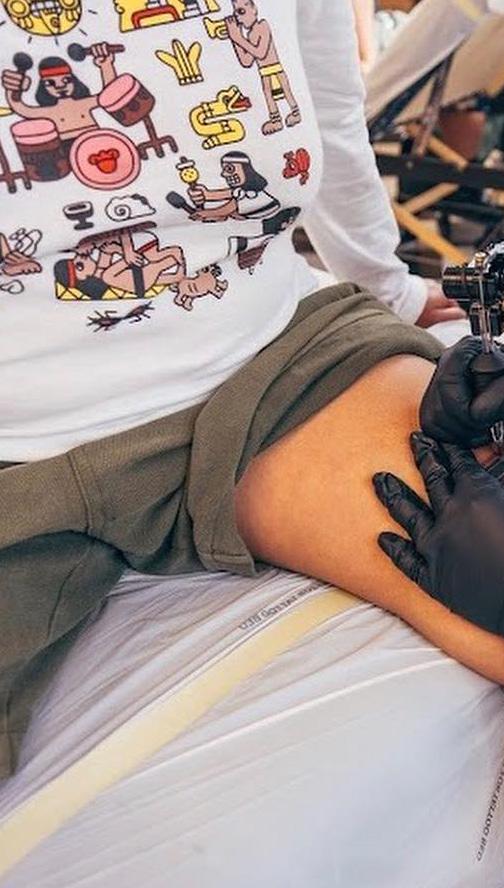

Escrito por Guillermo Noe Salazar y Ben Hernandez traducido por Clari Gomez



Desde que tenía cinco años, Alexa Moreno sabía que quería ser tatuadora.
“Lo que solía hacer es que compraba tatuajes temporales en la tienda por unas monedas y me los pegaba en el brazo y no me lavaba los brazos durante semanas”, dijo Moreno. “ Solía dibujarme a mi misma, en los brazos y también a mis compañeros de clase”
El arte de Moreno es una expresión distinta que se puede conectar con la comunidad Latine, Chicanx y queer. Se especializa en tatuajes de líneas finas negras y grises.
“Crecí viendo LA Ink, Miami Ink”, dijo Moreno. “ Supongo que verlo en televisión fue muy útil y culturalmente sólo creciendo en L.A y creciendo con compañeros chicanos y ver tatuajes y arte chicanos”.
Originalmente, Moreno se mudo a Humboldt en 2023 para que su pareja pudiera terminar la universidad en Cal Poly Humboldt (CPH). Mudarse a Humboldt puso nerviosa a Moreno porque no conocía el área y le preocupaba encontrar una comunidad. Sin embargo, fue capaz de encontrar una comunidad a través del folklórico, actuaciones de Danza Azteca y eventos organizados por Centro del Pueblo.
Pudo adaptarse aún más cuando empezó a trabajar en Sangha Tattoo Studio en Eureka y conoció a Jackie Silva, copropietaria y perforadora corporal. Sintió que Silva la comprendía realmente.
“Ya sabes, las dos somos chicanas del Sur de California y nos apasiona nuestra herencia y nuestra cultura, y ella lo incorpora mucho a su trabajo”, dice Silvia.
Silvia también compartió que Moreno y ella se unieron por su amor común a la cultura.
“Se siente genial tener a alguien con quien hablar y bromear”, dijo Silvia. “Tenemos los mismos chistes y todo eso”.
Aunque Moreno expresó su amor por el tatuaje desde muy pronto, no siempre contó con la aprobación de sus padres para su elección de carrera pro-
fesional. Al principio, su padre pensaba que los tatuajes eran para “pandilleros” y su madre no creía que fuera una carrera profesional, pero recibió el apoyo de amigos y profesores. A medida que progresaba como tatuadora, sus padres empezaron a ver su habilidad y su pasión, y que incluso como artista podía ganarse la vida y expresarse.
“ Supongo que mis padres querían que fuera a la universidad y estudiara, pero creo que para muchos padres inmigrantes, dedicarse a las artes o incluso trabajar por cuenta propia es algo que no se escucha o que da miedo”, dice Moreno.
Trabajando en el sector de tatuaje antes de venir a Humboldt Moreno comenzó su aprendizaje de tatuaje en el año 2020, justo antes de la pandemia de COVID-19. Durante ocho meses, aprendió a tatuar con una máquina de bobina tradicional en una tienda localizada en Inglewood.
Sin embargo, al principio de su aprendizaje tuvo que lidiar con otros artistas bebiendo alcohol, consumiendo drogas e incluso la acosaban. Después de estar en ese ambiente tóxico, ni siquiera pudo obtener su licencia para tatuar.
Al final se marchó para continuar su aprendizaje en otra tienda de tatuajes con un nuevo mentor.
Moreno pudo encontrar un puesto de aprendiz en una tienda de tatuajes exclusivamente femenina en San Pedro, California, llamada Black Sheep, donde pudo trabajar junto a otras chicanas.
Con un nuevo ambiente seguro y lleno de apoyo, pudo obtener su licencia para tatuar en 2020.
Su arte y sus inspiraciones
En cuanto a las inspiraciones de Moreno, “Empezó con la gente morena encarcelada”, dijo Moreno.
Se centra en temas relacionados con la cultura mesoamericana, la indigenidad, el arte callejero chicanx, el empoderamiento marrón y la roba callejera chola(o). Como Moreno creció como chicana en un hogar mexicano, aprendió sobre sus raíces y las diferentes tribus de México.
Algunos ejemplos de su obra utilizan símbolos mexicanos, dioses mesoamericanos como Kukulkan, plantas utilizadas en la cultura mexicana como el agave y los nopales, Danza Azteca y folklórico.
Estudiante de Cal Poly Humboldt Ernesto Saldaña, recibió tatuajes a juego con su mejor amigo de Moreno.
“Elegimos a Alexa porque vimos que su estilo artístico encajaba con lo que queríamos y que es hispana, así que sabíamos que se mantendría fiel a la cultura y los tatuajes salieron perfectos”, dijo Saldaña.
Desde que llegó a Humboldt, la ambición de Moreno no ha hecho más que crecer, ya que le apasiona la historia del tatuaje, el arte en la cultura mesoamericana y actualmente estudia en el College of the Redwoods para convertirse en profesora de arte. Moreno aspira a crear murales alrededor de Humboldt, especialmente en Eureka.
Puedes encontrar a Moreno en Instagram @labrujatatuu o en Sangha Tattoo Studio en Eureka

Para el video escanear el código QR
Photo essay: Slamming and jamming 'til the wheels fall of
On April 12, Humboldt Roller Derby’s (HRD) Root Force and Redwood Rollers defended their home turf against the Auburn Outlaws at Redwood Acres Event Center in Eureka. The Root Force won the first game 152 to 101. In game two, the Redwood Rollers brought home another victory, winning 173 to 150 points. This was HRD's last home game until September. As the team prepares for their next season, they will be hositng a few upcoming fundraisers.
On May 29, HRD will be hositng a Pints for Nonprofits fundraiser at the Blue Lake Casino from 6-9 p.m. It will include a live DJ, souvenirs and happy hour pricing for the duration of the event. This event is meant to raise money for HRD to travel across California, Oregon and Washington for upcoming tournaments. For more information, you can follow Humboldt Roller Derby on Instagram @humboldtrollerderby.


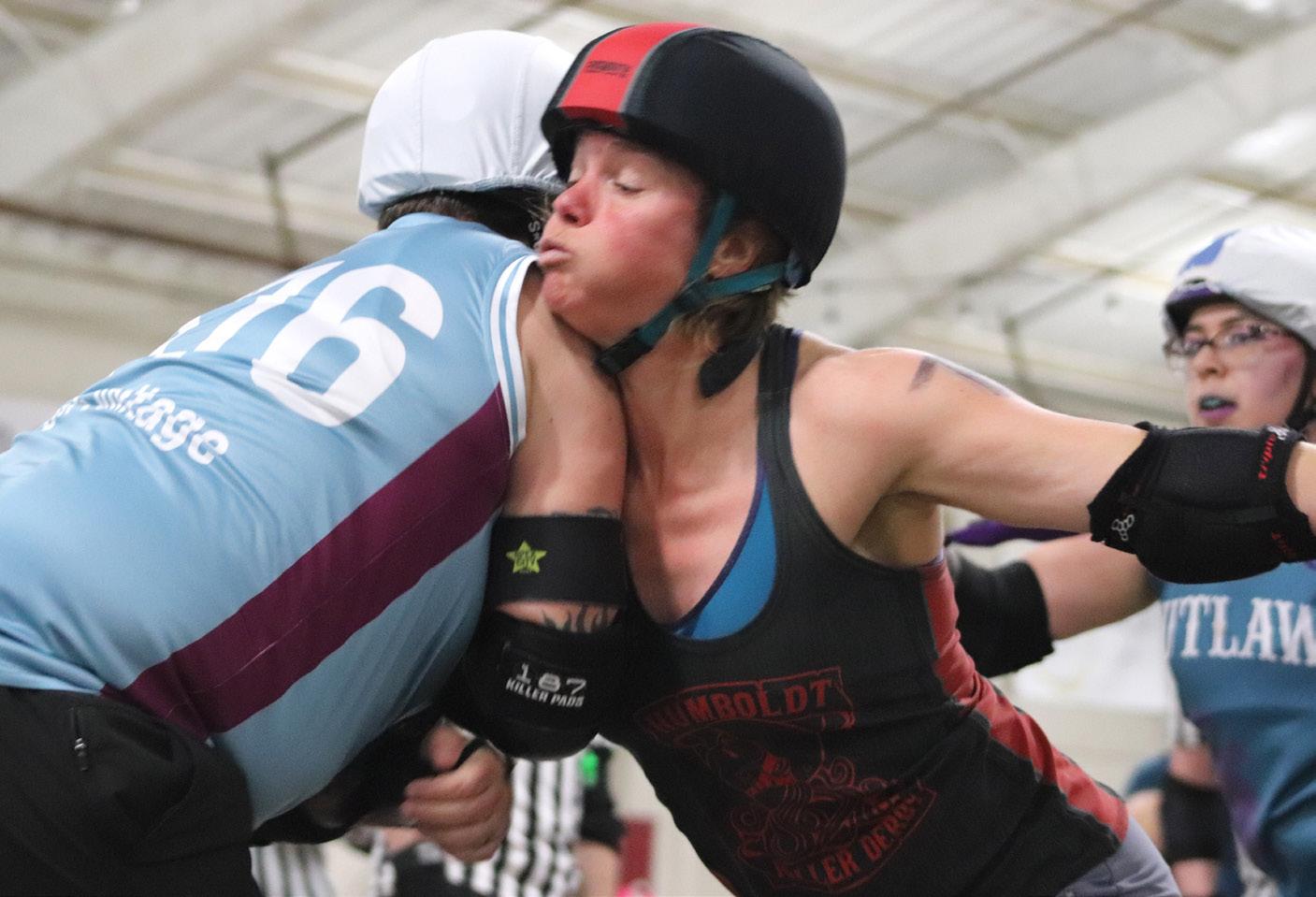


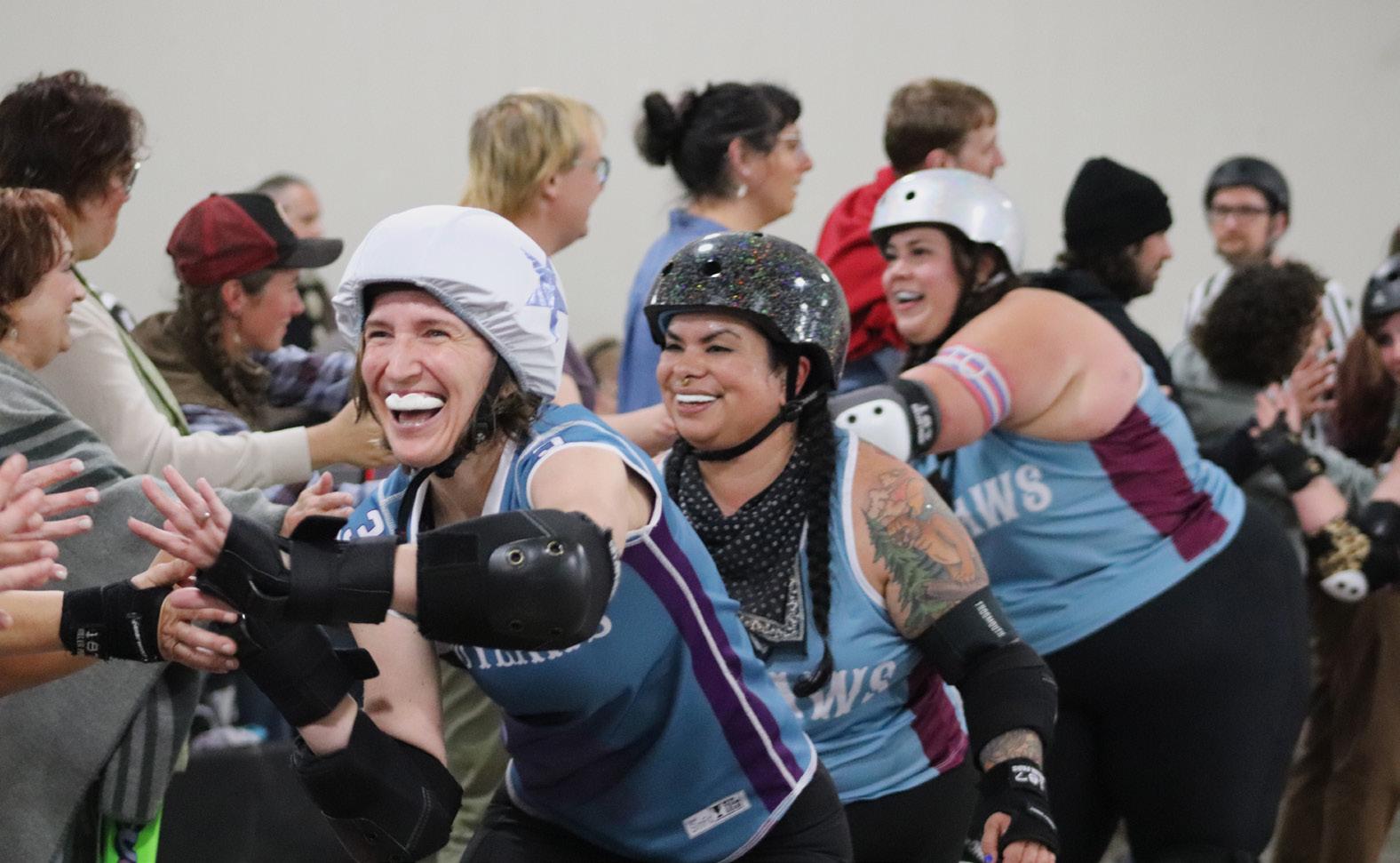

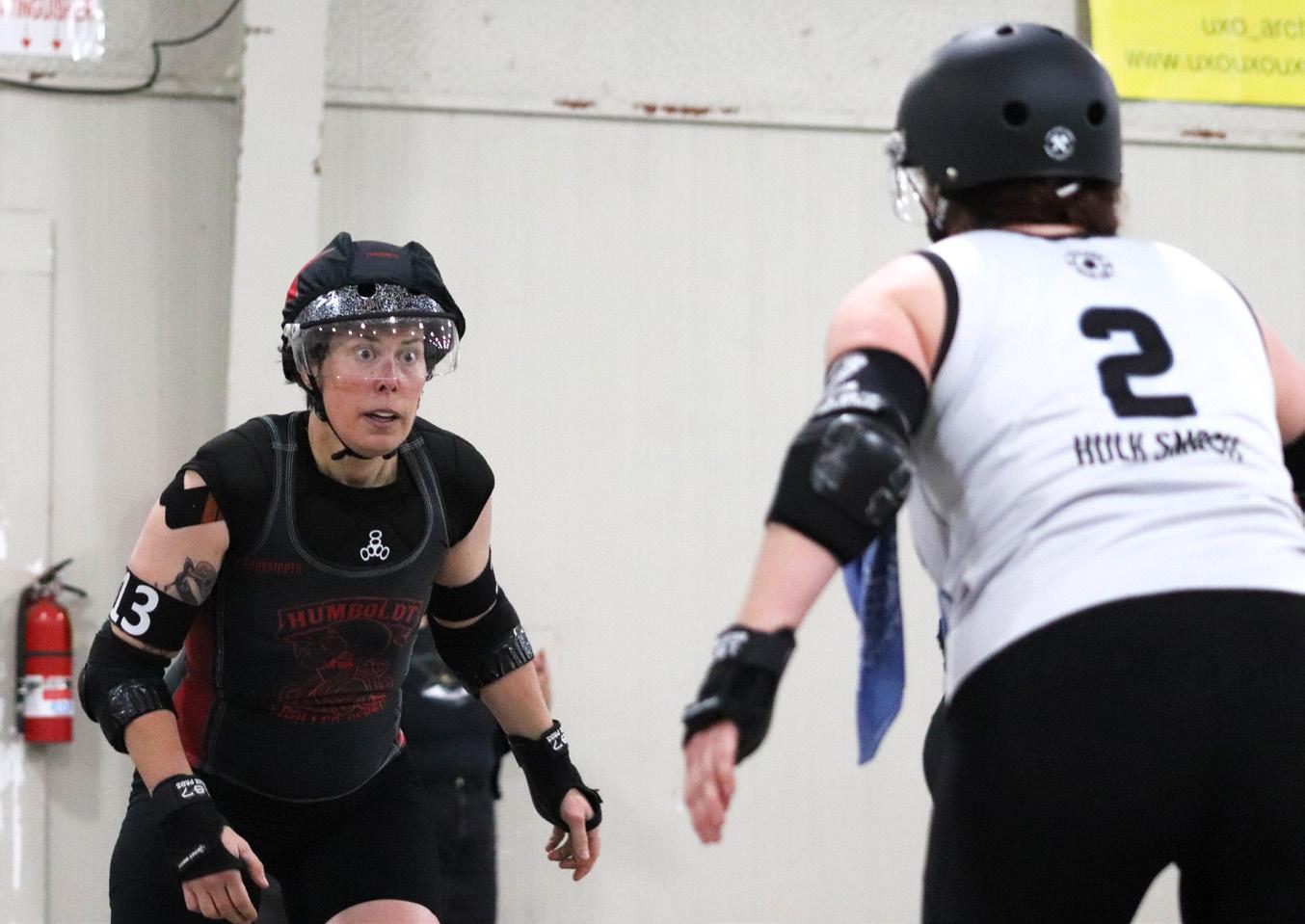
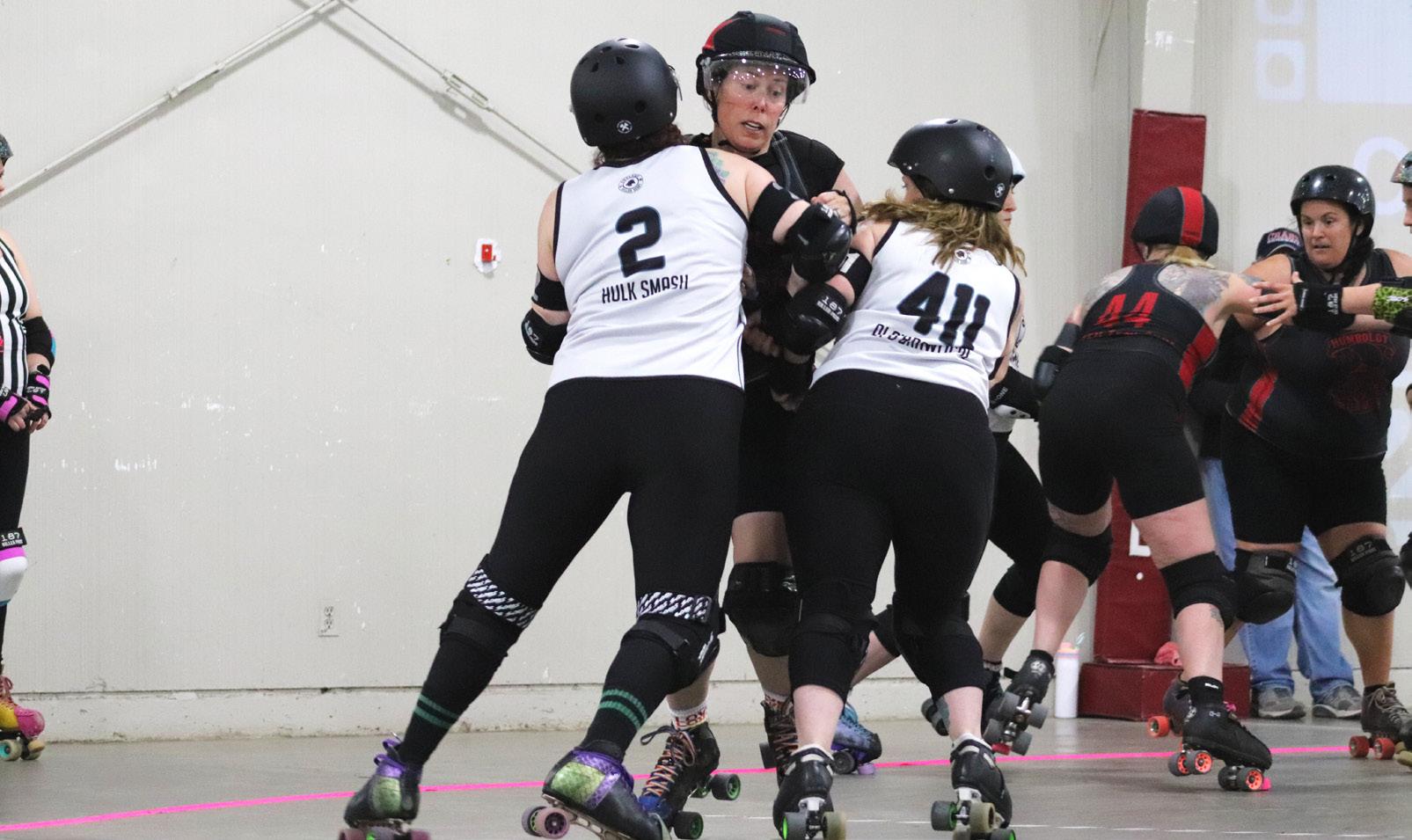

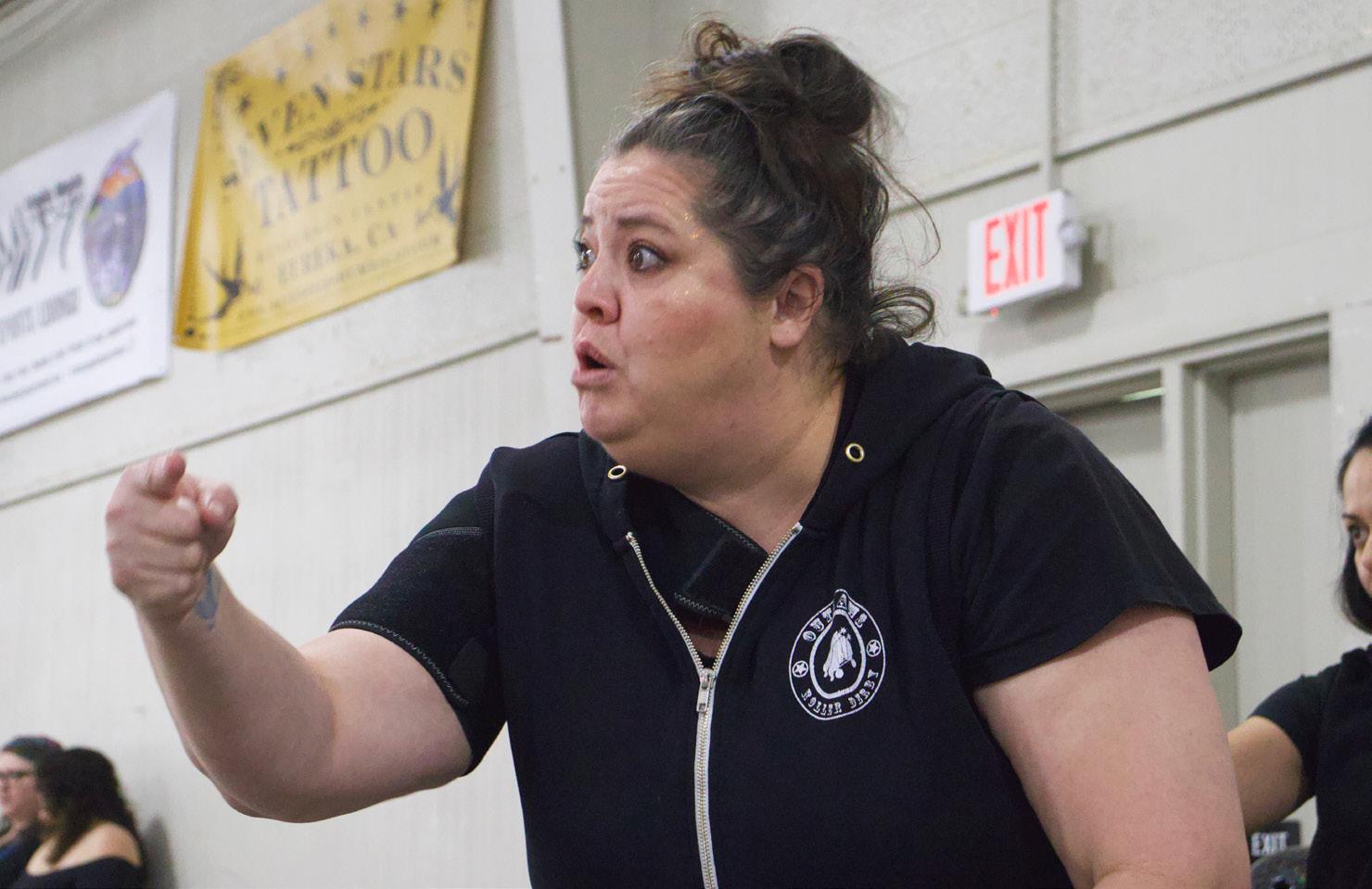
New Book Honors Humboldt’s Bilingual Portuguese Heritage Finishing Line Press presents
A story/poem of love and hope.
On her daily walks, struggling with the limitations of her aging body, Mrs. Silva becomes the immigrant spirit of the Azores, and of America. Her courage to endure reflects the heroism of women everywhere. With inspiring dignity, Mrs. Silva’s personal journey to the end of the lane becomes a passage to the edge of history. Bruna Dantas Lobato’s beautiful Portuguese translation connects Mrs. Silva Walks to the Azores, with the NorCal Portuguese community, and with the struggles of immigrant women throughout the Portuguese-speaking world.
All author proceeds will be donated to





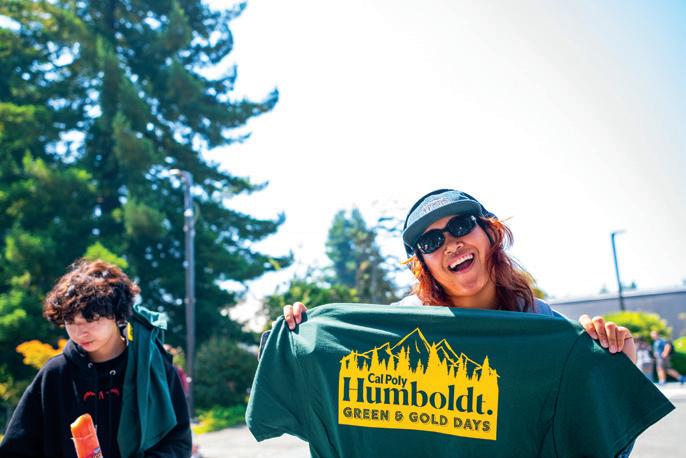








by Jordan Pangelinan
On April 14, 2025, Blue Origin, founded by Jeff Bezos sent an all women’s flight to space for 11 minutes. Amongst the women were Katy Perry, Gayle King, Lauren Sánchez (Bezos’ Fiance), Kerianne Flynn, civil rights activist Amanda Nguyen and former NASA engineer Aisha Bowe.
I’d like to point out that within the last month, documents reveal Trump’s plan to cut 20% of NASA’s overall budget. This would cause many missions to help environmental and climate research stop. It is not clear if these women had to pay for this flight. On the Blue Origin website people who want to go to space have to fill out the customer information form. You fill out two boxes, the last one being that you agree to a $150,000 dollar deposit (fully refundable) in order to begin the “order process”.
I wonder if the theory that they’re sending celebrities on these test flights to see if they can make Mars their new home after
they are done destroying earth is true.
It was a very utopian feeling seeing my childhood popstar go on a flight to space for 11 minutes, knowing the Department of Education is being targeted, poor people are only becoming poorer and there are mass ICE raids happening across the country. Yet Perry is announcing her new album to prove to young girls they “can do it too”, right, right…
Not trying to get all tinfoil hat guy on you but it’s a little weird, no? In this economy? With the way this country is falling? Use your money to help your daughters future education Perry!
There were two astronauts on that flight, Nguyen and Bowe. Nguyen is a rape survivor who transformed her own trauma into legislation, later drafting the Sexual Assault Survivor Bill of Rights. In flight Nguyen also became the first Vietnamese and Southeast Asian woman in space.
Escrito por Jordan Pangelinan y traducido por Gina Muñoz
En el 14 de abril del 2025, Blue Origin, fundado por Jeff Bezos mando un comando de mujeres hacia el espacio por 11 minutos. Entre las mujeres estaban Katy Perry, Gayle King, Lauren Sanchez (la prometida de Bezos), Kerianne Flynn, la activista de derechos civiles Amanda Nguyen y ex ingeniera de NASA Aisha Bowe.
Me gustaría mencionar que durante el mes pasado, documentos revelan el plan de Trump de cortar el 20% del financiamiento general de la NASA. Esto causaría que muchas misiones para ayudar a estudios ambientales y climáticos paren. No está claro si estas mujeres tuvieron que pagar por el viaje. En la página de Blue Origin, gente interesada en ir al espacio tienen que llenar un formulario de información del cliente. Tienes que llenar dos cuadros, el último diciendo que aceptas pagar $150,000 dólares (completamente reembolsable) para comenzar el “proceso de la orden.”
Me pregunto si la teoría de que el motivo por el cual están mandando a celebridades al espacio es para ver si pueden convertir a Marte en su nuevo hogar después de destruir el planeta tierra es cierto.
Fue un sentimiento muy utópico ver a mi popstar de la infancia tomar un viaje al espacio por 11 minutos sabiendo que el departamento de educación está siendo atacado, la gente pobre sigue convirtiéndose más y más pobre y hay redadas de ICE masivas a través del país. Sin embargo, Perry anuncia su nuevo álbum para demostrarle a otras niñas que ellas
también pueden lograrlo,” si, si, claro…
No quiero sonar loca pero, ¿En esta economía? ¿Con la manera en la que el país va de caída? Usa tu dinero para ayudar a la educación futura de tus hijas, Perry!
Hubieron dos astronautas en ese viaje, Nguyen y Bowe. Nguyen es una sobreviviente de violacion que transformó su trauma en legislación, eventualmente escribiendo el Sexual Assault Survivor Bill of Rights. Durante el viaje, Nguyen también se convirtió en la primera mujer vietnamita y del sureste de Asia en estar en el espacio.
Bowe, ex ingeniera aeroespacial en NASA y ahora emprendedora que se convirtió en la primera persona de herencia bahameña en viajar al espacio. Bowe la fundadora y CEO de STEMBoard tiene una misión hacia proyectos basados en STEM con el fin de un futuro más sustentable. Si nos enfocamos en estas mujeres que fueron al espacio, deberíamos enfocarnos en las astronautas de verdad (Nguyen y Bowe) quienes están luchando por un cambio y convirtiéndose en las mujeres en campos de trabajo dominado por hombres. No me gusta defender a compañías grandes especialmente sabiendo que mi dinero podría estar yéndose hacia ellas y podrían estar usándolo de una manera que no deberían. Sí comento en este tema sin saber mucho del día a día de la vida de un trabajador en una compañía espacial. Sin embargo, sí sé que mandar a celebridades o billonarios al espacio para que tengan la vista de sus vidas por
Bowe, a former aerospace engineer at NASA and now entrepreneur who became the first person of Bahamian heritage to travel to space. Bowe the founder and CEO of STEMBoard has a mission for STEM founded work to aim for a more sustainable future. If we are focusing on these women who went to space we should be focusing on the actual astronauts (Nguyen and Bowe) who are fighting for changes and becoming the women in male dominated fields.
I don’t like defending big companies especially knowing my money could possibly be going to them and using it where it shouldn’t be. I do speak on this topic not knowing much about the day in the life of an employee at a space company. However I do know that sending billionaires or celebrities to space to see the best view of their life for 11 minutes is a little diabolical. We are funding genocide overseas and
being complicit in many crimes against humanity while our own government system is being torn apart from the inside out. Big Brother is not your friend for the love of GOD!
I do want to leave you with a verse from a song that I feel really describes my feelings and the United States’ current situation. Music is a form of expression, a part of our First Amendment. Enjoy the resistance while we can still use it, freely.
“Let My People Go” by Darondo 2005
“Man to your rocket ship / Take you to the moon / A million dollar mission / Just to bring back a piece of rock / We got starvation, panic across the land / And here's a fool in a rocket ship / Tryina' be superman”
* This only refects the opinion of the author, not of the newspaper as a whole.

11 minutos es un poco diabólico. Estamos financiando un genocidio foráneo y siendo cómplices de tantos crímenes en contra de la humanidad mientras que nuestro sistema gubernamental esta siendo destrozado desde adentro. Big Brother no es tu amigo, por el amor de DIOS!
“Let My People Go” by Darondo 2005 “Man to your rocket ship / Take you to the moon / A million dollar mission / Just to bring back a piece of rock / We got starvation, panic across the land / And here's a fool in a rocket ship / Tryina' be superman”
* Esto solo refeja la opinión del autor, no del periódico en sí.
Quiero dejarles un verso de una canción que siento describe mis sentimientos hacia la situación actual de los Estados Unidos. La música es una forma de expresión, una parte de nuestra primera enmienda. Disfruten de la resistencia mientras podamos usarla, libremente.
by Joahnna Tool

With ICE conducting arrests of student activists from universities across the country, I have been refecting on the encampments for Palestine that occurred on our very own campus just one year ago and asking myself have people just moved on?
It feels unreal to me, waking up every morning to a new headline, reading about how marginalized communities around the world are continually being targeted by racist heteropatriarchal systems of power, yet having to go on about my day to day life as a student.
How can we be expected to keep it pushing when our world is seemingly falling apart in front of us? It has now been 573 days of an ongoing genocide in Palestine, yet with time passing by, I have seen less and less people speaking out.
I am in my fnal semester here at Humboldt and as I walk around our campus now, I constantly see reminders of past events. No matter how many shabby cover up paint jobs it takes, I will never unsee the messages calling for a “Free Gaza" marked over walls everywhere. Only one year ago, April 22, 2024
marked the frst night where student activists began their occupation of Siemens Hall. I vividly remember having seen the frst wave of social media posts, seeing that people had barricaded themselves inside, with an alarming number of law enforcement ofcers already on the scene. Fear and adrenaline fueled me as I rushed to campus that evening, trying to fgure out what we could do to show our support to those students inside and outside. I knew that no matter what, we were not going to leave until the police ofcers were gone.
It was terrifying hearing reports that there had been calls for police backup all the way from Redding. Although I couldn’t be too shocked knowing that the administration was behind these eforts, after all they have always fallen short when it comes to protecting students of color (may I remind you all of the housing crisis).
While some may have seen the campus closures as an excuse to slack of on their fnals, the reality is that for most people it was a time to come together to show our solidarity with the Palestinian people.
The way in which students and community members rallied together to help start up frst aid, mutual aid and food tents the following days demonstrated the resilient spirit embodied by collective demonstration.
As a critical race, gender and sexuality studies major, I have spent a lot of time in my ethnic studies classes engaging in discussions about how settler colonialism operates and how we can do the work to dismantle white supremacy. To then see that knowledge taken out of a classroom space and put into practice during the encampments was next level.
Yet there is a part of me that can’t help but feel that some aspects of the actions taken last year were superfcial. While I in no way want to take away from the overall impact that the encampments had, I do want to acknowledge that as a student of color it felt like the main focus slowly became distorted as time went on. At some point it was as if people were only there to enact a somewhat dystopian resistance fantasy. Ultimately I believe it comes down to our positionality and not losing sight
of the reasons we are choosing to engage in these political demonstrations in the frst place. If you feel that I’m being harsh maybe take that as a sign to do some inner refection about the space that you’re occupying.
In this day and age of social media where people often just post to make themselves look good for their followers, treating activism as a trend, it is necessary to acknowledge that there have been those who have kept the momentum going, working everyday to call for a liberated Palestine.
Despite eforts to limit student advocacy across the nation made by the current president or even our own administration, we will continue our fght for a decolonial future. Students united will never be divided. And if it hasn’t been clear enough FREE PALESTINE FROM THE RIVER TO THE SEA.
* This only refects the opinion of the author, not of the newspaper as a whole.
Escrito por Joahnna Tool
Con ICE realizando arrestos de activistas estudiantiles de universidades a través del país, yo he estado reflejando en los campamentos para Palestina que ocurrieron en nuestro propio campus hace solo un año y preguntándome: ¿la gente simplemente siguió adelante como nada pasó?
Se siente irreal a mi, despertar cada mañana a un nuevo titular, leyendo de cómo las comunidades marginadas alrededor del mundo están siendo atacadas por sistemas racistas heteropatriarcales de poder, aun así, tengo que seguir con mi vida cotidiana como estudiante.
¿Cómo podemos esperar que sigamos adelante cuando nuestro mundo aparentemente se está desmoronando delante de nuestros ojos? Han pasado ya 573 dias de un genocidio en curso en Palestina, pero con el tiempo he visto cada vez menos gente alzar la voz.
Yo estoy en mi último semestre aquí en Humboldt y en lo que caminó por nuestro campus ahora, veo constantemente recordatorios de eventos pasados. Por mucho que cubran con pintura, nunca olvidaré los mensajes que piden una “Gaza Libre” escritos en los muros por todas partes.
Solo fue hace un año, Abril 22, 2024 marcó la primera noche donde activistas estudiantiles empezaron la ocupación de Siemens Hall. Recuerdo vívidamente haber visto la primera ola de publicaciones en las redes sociales, viendo que la gente se había atrincherado adentro, con una cantidad alarmante de policías ya en la escena. El miedo y adrenalina me alimentaron mientras corría al campus esa tarde, tratando de averiguar qué podíamos hacer para mostrar nuestro apoyo a los estudiantes de dentro y de fuera. Sabía que, pasara lo que pasara, no nos iríamos hasta que la policía se fuera.
Fue aterrador escuchar informes de que había llamadas de refuerzos policiales desde Redding. Aunque no podía sorprenderme saber que la administración estaba detrás de estos esfuerzos, despues de todo siempre se han fallado cuando se trata de proteger a los estudiantes de color (permitanme recordarles a todos la crisis de la vivienda).
Mientras algunos pueden haber visto los cierres de campus como una excusa para descuidar sus exámenes finales,
la realidad es que para la mayoría de la gente era un tiempo para reunirse y demostrar nuestra solidaridad con la gente de Palestina.
La manera en que los estudiantes y los miembros de la comunidad se unieron para ayudar a poner puestos de primeros auxilios, ayuda mutua y alimentos los días siguientes demostró el espíritu resiliente encarnado por la manifestación colectiva.
Como especialidad de estudios críticos sobre raza, género y sexualidad, he dedicado mucho tiempo en mis clases de estudios étnicos teniendo discusiones sobre cómo funciona el colonialismo y cómo nosotros podemos hacer el trabajo de desmantelar la supremacía blanca. Ver cómo ese conocimiento fue llevado fuera de un salón y puesto en práctica durante los campamentos fue una experiencia extraordinaria.
Sin embargo, hay una parte de mi que no puede evitar sentir que algunos aspectos de las acciones tomadas el año pasado fueron superficiales.
Mientras de ninguna manera quiero quitarle importancia al impacto general que tuvieron los campamentos, si quiero reconocer que, como estudiante de color, senti que el enfoque principal se fue distorsionado lentamente con el paso del tiempo. En algún momento fue como si la gente solo estuviera allí para representar una fantasía de resistencia distópica. A lo largo creo que todo se reduce a nuestra posicionalidad y no perder de vista las razones por las que elegimos participar en estas manifestaciones políticas en primer lugar. Si sientes que estoy siendo dura tal vez tómatelo como una señal para hacer una reflexión interna sobre el espacio que estás ocupando. En esta época de redes sociales donde la gente a menudo pública solo para quedar bien ante sus seguidores,
tratando el activismo como una tendencia, es necesario reconocer que ha habido quienes han mantenido el impulso, trabajando todos los días para pedir una Palestina liberada.
A pesar de los esfuerzos del actual presidente o incluso de nuestra propia administración por limitar la defensa estudiantil en todo el país, continuaremos nuestra lucha por un futuro descolonial. Los estudiantes unidos jamás estarán divididos. Y por si no ha quedado suficientemente claro: ¡PALESTINA LIBRE DESDE EL RÍO HASTA EL MAR!
*Esto sólo refeja la opinión del autor, no del periódico en su conjunto.



by Alba Guadalupe Galvan
As someone who is chronically online I have picked sides in internet drama that had nothing to do with me. Why? Because I thought I had all the information. And if it’s online, I felt like I had the right to judge who was “in the right.” Sounds ridiculous right? That's kind of what cyberbullying sounds like.
But I think this is something a lot of us do, and constantly on a daily basis. We see one clip, or one comment, and we assume it tells the whole story—point blank, period. I’m here to say that’s a really dumb way of thinking. Why are we forming such strong opinions on situations that don’t even concern us?
Social media makes it incredibly easy for people to become bullies, I know I for one never expected to say that but it's true. Take the situation between Selena Gomez and Hailey Bieber, for example. After Gomez posted a TikTok about her eyebrows, rumors started that Bieber and Kylie Jenner posted a video making fun of her. From there, the internet went crazy. Bieber was accused of being a mean girl and even copying Gomez But then it flipped. Hailey herself became the target of bullying, hate and online harassment and to this day it's still happening.
Cyberbullying has become completely normalized. Remember in elementary school when we had assemblies teaching us not to bully people online? Yeah, clearly that didn’t stick. We forget that influencers and celebrities are still real people just like us common folk.
But let’s be real—not everyone has good intentions. That brings me to the Anna Paul and Mikaela Testa situation. Anna is known for promoting body positivity and mental health. She even started her own skincare brand. But Mikaela, who has been receiving hate and death threats for years, recently started exposing Anna. She shared personal experiences, messages, and evidence— claiming that Anna’s brother, Atis Paul, harmed her and that Anna is protecting him while marketing to a young audience and based on this information alone I already believe I should be on Mikaela's side.
What I’m trying to say is, we don’t really know these people. Not celebri-
ties, not influencers. They show us what they want to, and we fill in the rest. Like go look at Wattpad and that in itself shows how much we think of people, we already believe we know them but we don't and I believe we never will.
It’s like what our parents and teachers always told us—be careful who you trust. The world is scary, and it’s way too easy to believe someone just because their life looks perfect online. The sad part of all this, influencers and celebrities are not the only ones getting cyberbullied. It's like the saying goes, if you have nothing nice to say, don't say it. These are real people with real emotions. If you don't like what you see, block them.
* This only refects the opinion of the author, not of the newspaper as a whole.
Escrito por Alba Guadalupe Galván y traducido por Gina Muñoz
Como alguien que está crónicamente en línea, he elegido lados en drama de internet que no tenían nada que ver conmigo. ¿Por qué? Porque pensé que tenía toda la información. Y si es en línea, sentí que tenía derecho de juzgar quién estaba "en lo correcto." Suena ridículo, ¿verdad? Así es como suena el ciberbullying. Pero creo que esto es algo que muchos de nosotros hacemos, y constantemente a diario. Vemos un video, o un comentario, y asumimos que cuenta toda la historia, punto y final. Estoy aquí para decir que esa es una forma realmente tonta de pensar. ¿Por qué formamos opiniones tan firmes sobre situaciones que ni siquiera nos incumben?
Las redes sociales hacen que sea increíblemente fácil para las personas convertirse en acosadores, sé que nunca esperé decir eso, pero es cierto. Tomemos como ejemplo la situación entre Selena
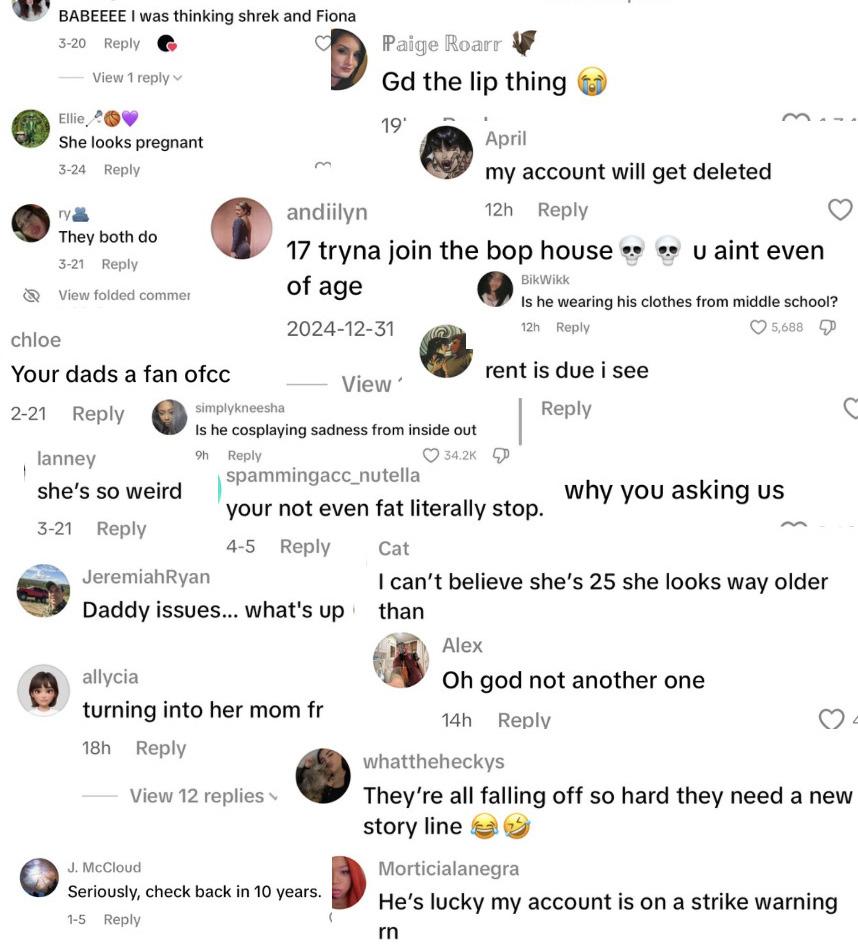
Gomez y Hailey Bieber. Después de que Gomez publicará un TikTok sobre sus cejas, comenzaron los rumores de que Bieber y Kylie Jenner publicaron un video burlándose de ella. A partir de ahí, el Internet se volvió loco. Bieber fue acusada de ser una chica mala e incluso de copiar a Gomez– Pero luego cambió: la propia Bieber se convirtió en blanco de bullying, odio y acoso en línea y hasta el día de hoy sigue sucediendo.
El ciberbullying se ha normalizado por completo. ¿Recuerdas en la escuela primaria cuando teníamos asambleas que nos enseñaban a no acosar a las personas en línea? Sí, está claro que eso no funcionó. Olvidamos que los influencers y las celebridades siguen siendo personas reales, al igual que nosotros, la gente común.
Pero seamos realistas: no todo el mundo tiene buenas intenciones. Eso me lleva a la situación de Anna Paul y Mikaela Testa. Anna es conocida por promover body positivity y salud mental. Incluso comenzó su propia marca de cuidado de la piel. Pero Testa, que ha estado recibiendo odio y amenazas de muerte durante años, recientemente comenzó a exponer a Paul. Compartió experiencias personales, mensajes y pruebas, afirmando que el hermano de Testa, Atuis Paul, le hizo daño y que Testa lo está protegiendo mientras se dirige a un público joven y, basándome solo en esta información, ya creo que debería estar del lado de Paul.
Lo que estoy tratando de decir es que realmente no conocemos a estas personas. Ni famosos, ni influencers. Ellos nos muestran lo que quieren, y nosotros completamos el resto de la historia. Nada más ve a Wattpad y eso en sí muestra lo mucho que pensamos en otra gente, ya creemos que los conocemos pero no los conocemos y creo que nunca pasará.
Es como lo que nuestros padres y maestros siempre nos dijeron: ten cuidado en quién confías. El mundo es aterrador, y es demasiado fácil creerle a alguien solo porque su vida se ve perfecta en línea. Lo triste de todo esto es que los influencers y las celebridades no son los únicos que sufren ciberbullying. Es como dice el refrán, si no tienes nada bueno que decir, no digas nada. Son personas reales con emociones reales. Si no te gusta lo que ves, bloquealos.
*Esto sólo refeja la opinión del autor, no del periódico en su conjunto.









nutrition, gut health, and fnals: Oh my!
by Jessica de Laguna
Have you ever heard the gut referred to as “the second brain”? There’s a reason for that — and during finals week, keeping your gut healthy might just be the brain boost you didn’t know you needed.
Oscar Mogollon Maticorena, bilingual CalFresh outreach coordinator for the North Coast Growers’ Association, has a fun idea to lighten the mood before finals — and support gut health for optimal brain function.
Fermentation fiesta: Sauerkraut, kimchi and massages
“I would say, have sauerkraut fermentation parties. Make kimchi. Have a kimchi party,” Oscar Maticorena said. “You know, have friends over. Everyone splits up the labor, cuts up some fruit.”
The idea is that balancing the bacteria in your gut can influence how your brain functions. Probiotics, the beneficial bacteria found in fermented foods, help maintain a healthy balance of gut bacteria, which may support both gut and brain health.
You heard the man — gather your crew, grab some kimchi and transform finals stress into gut-loving, probiotic fun with your friends.
Fresh Food for well-being
Students should know that EBT benefits stretch further than many think — including at local farmers markets. Oscar Maticorena said you can buy fruits and vegetables, plus plants that produce food you can grow at home. He emphasized that access to fresh food is crucial for overall well-being.
Don’t miss out on benefits
Many students don’t know they may qualify for nutrition assistance through CalFresh — and finals week is a great time to make sure you're receiving your full benefits. Oscar Maticorena highlights the Market Match program, which stretches EBT dollars.
“It allows individuals to pull benefits from their EBT card in the form of copper tokens,” Oscar Maticorena said. “Then you get a $15 match in silver tokens — which are good for fruits, vegetables and plant starts.”

Plant starts, where seeds are sprouted for you, are a perfect way to kick off your first herb garden. All you need to do is take them home and plant them in soil.
All it takes is sun and love
When it comes to growing your own greens, that’s the motto of Jay Nord, a horticultural therapist, behavioral analyst, and owner of Sapience Therapeutic Farms.
“All it takes is sun and love,” Nord said, wearing a Star Wars t-shirt and radiating Obi-Wan-level calm. “Be one with earth.”
At his farm, the therapy doesn’t end at the soil.
“The color green is therapeutic and being outside,” Nord said. “My chickens and goats are therapeutic animals, being with them is a way to get grounded.”
While not everyone can escape to a goat-filled refuge, Nord emphasizes that grounding yourself in nature — even just a walk through green space — can improve your state of mind.
“We can hear better when we are in a relaxed state,” Nord said. “That helps us respond better.”
Whether it's with your roommate or your study group, staying centered and grounded is key when stress levels spike.
Tiny greens, big power
Kendall Elkins, owner of Freshwater Family Farm, is a microgreens maestro who champions nutrient-dense food — especially during times when you might not have the appetite (or time) to eat a full meal.
“Microgreens give you more nutrients per bite. Micro broccoli have forty times the amount of nutrients as a standard broccoli floret you can buy at the grocery store,” Elkins said. “My mom had cancer and could have a few bites of microgreens and I knew she was getting the nutrients she needed.”
So when you’re cramming and the idea of a full plate feels overwhelming, reach for a handful of microgreens. A micro bite could make the macro difference between brain fog and mental clarity.
Herbs, water and a little magic
Sophia Steinwachs, herbalist and owner of Woven Hearts Herb Farm, encourages students to explore herbs for gut and immune support.
“Herbs have antimicrobial effects — especially Mediterranean herbs like rosemary, thyme, and oregano,” Steinwachs said. “They’re also beneficial because of their aromatic oils.”
If you’re new to herbs, she suggests keeping it simple.
“Play around with herbs. Put them in your water to get to know them on a deeper level,” Steinwachs said. “Nothing complicated.”
Steinwachs shared that herbs can improve digestion, circulation and immune function — especially helpful when students are living on coffee, cup noodles and granola bars. If you’re like me and stress causes some, uh, uncomfortable digestion issues, a little rosemary-infused water might be a gentle and pleasant solution.
Gut check before the test
As finals week approaches, remember: nourishing your body is just as important as prepping your flashcards. Whether you’re throwing a fermentation party, sprinkling microgreens on your lunch, sipping rosemary water or walking through the redwoods — it all adds up. Because during finals, your brain may be doing the test-taking — but your gut is setting the stage for success.
*This article refects the opinion of the author, not of the newspaper as a whole.
Nutrición, salud intestinal y exámenes fnales: ¡Ay dios!
Escrito por Jessica de Laguna y traducido por Clari Gomez
Alguna vez has oído del intestino como “¿el segundo cerebro?" Hay una razón para ello – durante la semana de los exámenes finales, mantener los intestinos sanos puede ser el estímulo cerebral que no sabías que necesitabas.
Oscar Mogollon Maricorena, coordinador bilingüe de CalFresh para la asociación de cultivadores de la Costa Norte, tiene una idea divertida para animar el ambiente antes de los exámenes finales – y favorecer la salud intestinal para una función cerebral óptima.
Fiesta de la fermentación: Repollo fermentado, kimchi y masajes
“ Yo diría, haz fiestas de fermentación de repollo. Hagan kimchi. Haz una fiesta de kimchi”, dice Oscar Maticorena. “Invita a tus amigos. Todos se reparten el trabajo, cortan fruta.”
La idea es que el equilibrio de las bacterias intestinales puede influir en el funcionamiento del cerebro. Los probióticos, las bacterias beneficiosas que se encuentran en los alimentos fermentados, ayudan a mantener un equilibrio saludable de las bacterias intestinales, lo que puede favorecer tanto la salud intestinal como la cerebral.
Ya los has oído – reúne a tu equipo recoge un poco de kimchi y transforma el estrés de los finales en diversión probióticos y amante de los intestinos con tus amigos.
Alimentos frescos para el bienestar
Los estudiantes deben saber que los beneficios de EBT se extienden más allá de los que muchos piensan – incluyendo en los mercados agricultores locales. Oscar Maticorena dijo que se puede comprar frutas y verduras, además de plantas que producen alimentos que se pueden cultivar en casa. Subrayó que el acceso a alimentos frescos es crucial para el bienestar general.
No se pierda las ventajas
Muchos estudiantes no saben que pueden calificar para asistencia nutricional a través de CalFresh – y la semana de finales es un buen momento para asegurarse de que está recibiendo todo sus beneficios. Oscar Maticorena destaca el programa Market Match, que estira los dólares de EBT.
“ Permite a las personas sacar beneficios de su tarjeta EBT en forma de fichas de cobre”, dijo Oscar Maticorena. “Después obtienes un partido de $15 en fichas de plata – que son buenos para las frutas, verduras y plantas”.
Las semillas germinadas son una forma perfecta de poner en marcha tu primer jardín de hierbas aromáticas. Solo tienes que llevarlas a casa y plantarlas en la tierra.
Todo lo que se necesita es sol y amor
Cuando se trata de cultivar tus propias verduras, ese es el lema de Jay Nord, terapeuta hortícola, analista de conducta y propietario de Sapience Therapeutic Farms.
“Todo lo que se necesita es sol y amor”, dijo Nord, usando una camiseta de Star Wars y transmitiendo una calma digna de Obi-Wan. “Sé uno con la tierra”.
En su granja, la terapia no termina en la tierra.
“El color verde es terapéutico, y estar al aire libre también", dijo Nord. “Mis gallinas y cabras son animales terapéuticos, estar con ellos es una forma de conectar con el presente”.
Aunque no todos pueden escapar a un refugio lleno de cabras, Nord enfatiza que conectar con la naturaleza —incluso solo caminando por un espacio verde— puede mejorar tu estado mental.
“Podemos escuchar mejor cuando estamos en un estado de relajación”, dijo Nord. “Eso nos ayuda a responder mejor”.
Ya sea con tu compañero de cuarto o tu grupo de estudio, mantenerte centrado y con los pies en la tierra es clave cuando el estrés se dispara.
Pequeños brotes, gran poder Kendall Elkins, propietaria de Freshwater Family Farm, es una maestra de los microgreens que promueve los alimentos densos en nutrientes —especialmente en épocas en que quizá no tengas apetito (o tiempo) para una comida completa.
“Los microgreens te dan más nutrientes por bocado. El micro brócoli tiene cuarenta veces la cantidad de nutrientes que un florete de brócoli común que puedes comprar en el supermercado”, dijo
Elkins. “Mi mamá tenía cáncer y podía comer solo unos bocados de microgreens, y yo sabía que estaba recibiendo los nutrientes que necesitaba”.
Así que cuando estás estudiando sin parar y la idea de un plato lleno te abruma, recurre a un puñado de microgreens. Un micro bocado podría marcar la diferencia entre la niebla mental y la claridad.
Hierbas, agua y un poco de magia
Sophia Steinwachs, herbolaria y propietaria de Woven Hearts Herb Farm, alienta a los estudiantes a explorar el uso de hierbas para apoyar la salud digestiva e inmunológica.
“Las hierbas tienen efectos antimicrobianos —especialmente las hierbas mediterráneas como el romero, el tomillo y el orégano”, dijo Steinwachs. “También son beneficiosas por sus aceites aromáticos”.
Si eres nuevo en el mundo de las hierbas, ella recomienda empezar con algo sencillo.
“Juega con las hierbas. Ponlas en tu agua para conocerlas a un nivel más profundo” ,dijo Steinwachs. “Nada complicado”.
Steinwachs compartió que las hierbas pueden mejorar la digestión, la circulación y la función inmunológica —lo cual es especialmente útil cuando los estudiantes viven a base de café, fideos instantáneos y barras de granola. Si eres como yo y el estrés te provoca, digamos, ciertos problemas digestivos incómodos, un poco de agua con infusión de romero podría ser una solución suave y agradable.
Revisión intestinal antes del examen
A medida que se acercan los exámenes finales, recuerda: nutrir tu cuerpo es tan importante como repasar tus tarjetas de estudio. Ya sea que organices una fiesta de fermentación, le pongas microgreens a tu almuerzo, tomes agua con romero o camines entre los redwoods —todo suma. Porque durante los exámenes, tu cerebro puede ser el que responde pero es tu intestino el que crea las condiciones para el éxito.
*Este artículo refeja la opinión del autor, no del periódico en su totalidad.


Pictured: First row (left to right): Ryndi Greenwell - reporter, Jessica de Laguna - reporter, Vanessa Saltos - News editor, Joahnna Tool - reporter/photographer and Maryanne Casas-PerezEditor-in-Chief
Second row (left to right): Ryan Diaz - reporter, Ben Hernandez - Life and Arts editor, Leslie Castillo - videographer and Jordan Pangelinan - Social Media coordinator
Third row (left to right): Henry Lagunas - reporter/videographer, Giancarlo Muñoz - photographer, Bryan Pérez Bado - translator, Jacqueline Zuniga - reporter, Noelle Doblado - Managing editor and Ocean Edgar - reporter/photographer
Not pictured: Connor McGinley - reporter, Guillermo Noe Salazar - Lead distributor, Yocelin Rios - translator, Clari Gomez - translator, Alba Galvan - reporter, Marisabel Perez Moreno - translator, Gina Muñoz - reporter/translator and Kumiye Nakadate - graphic designer